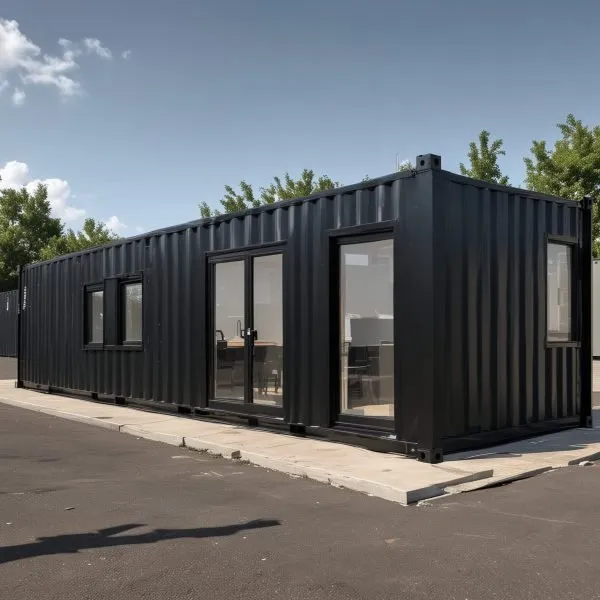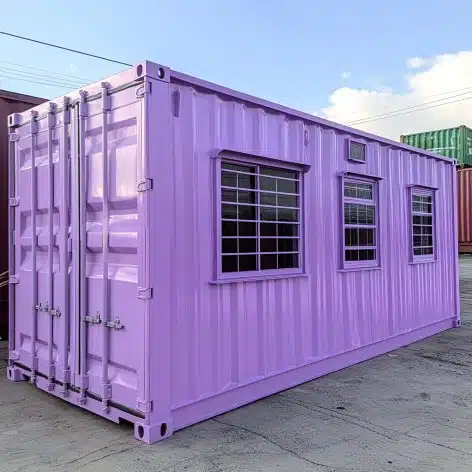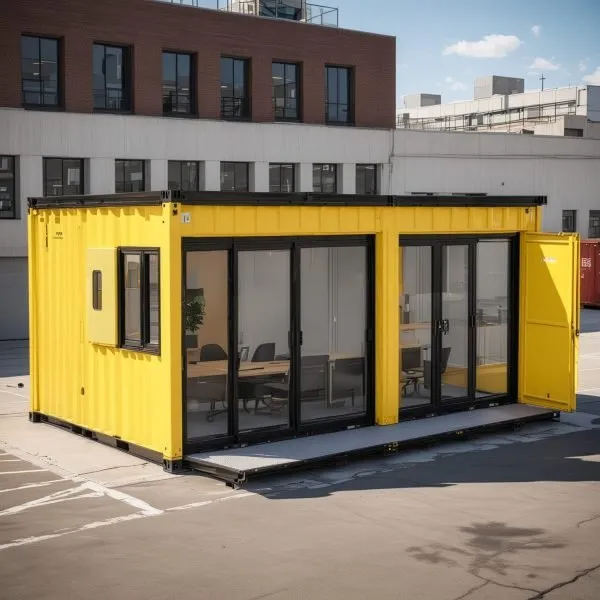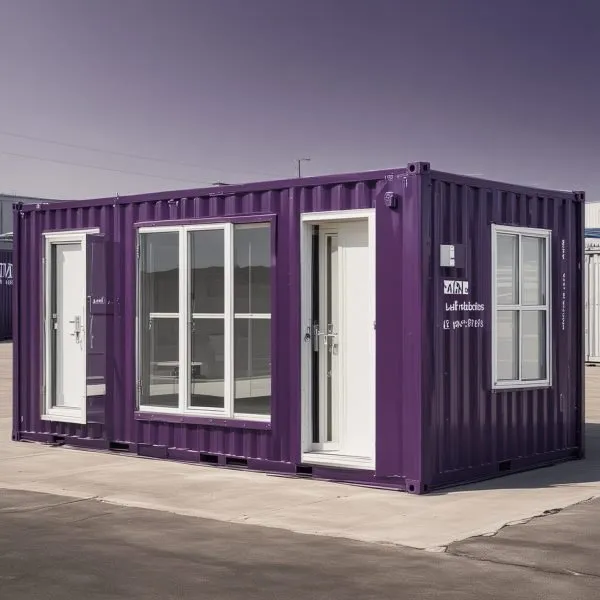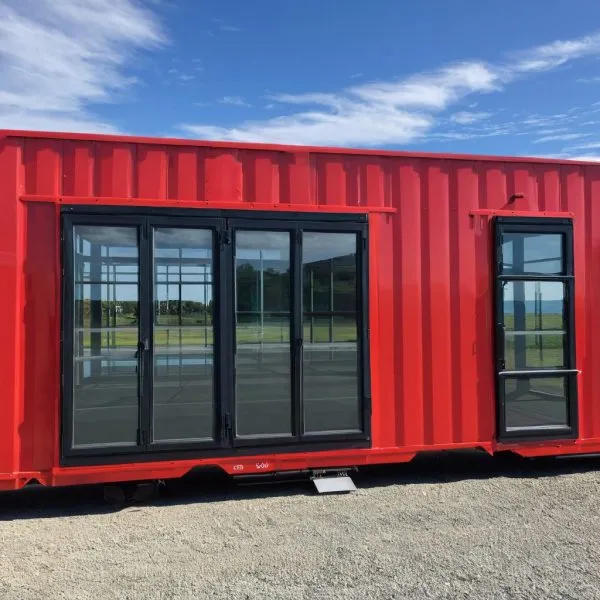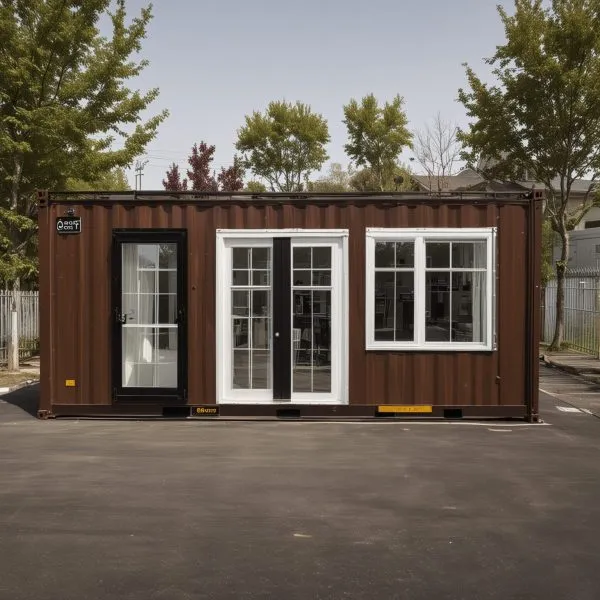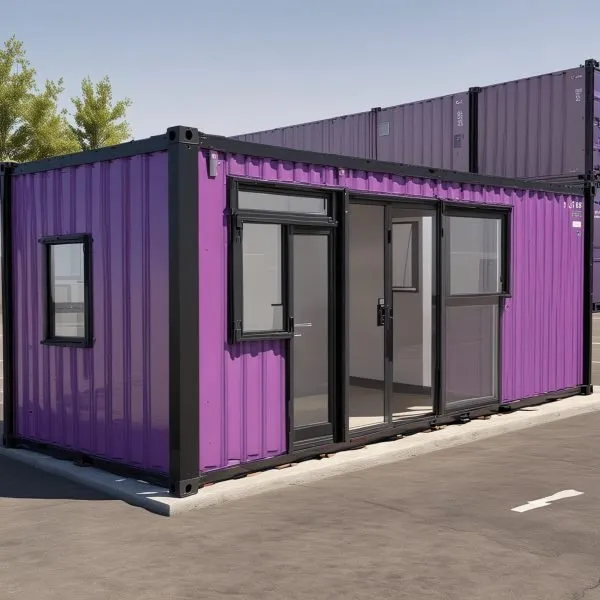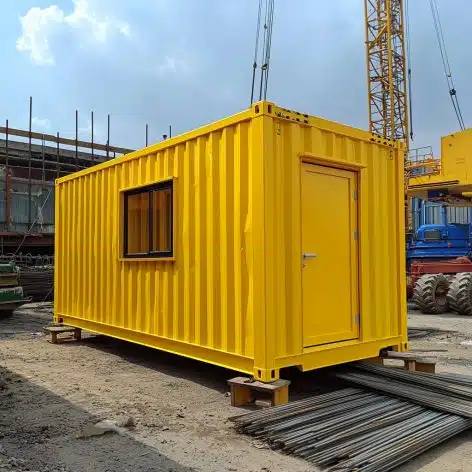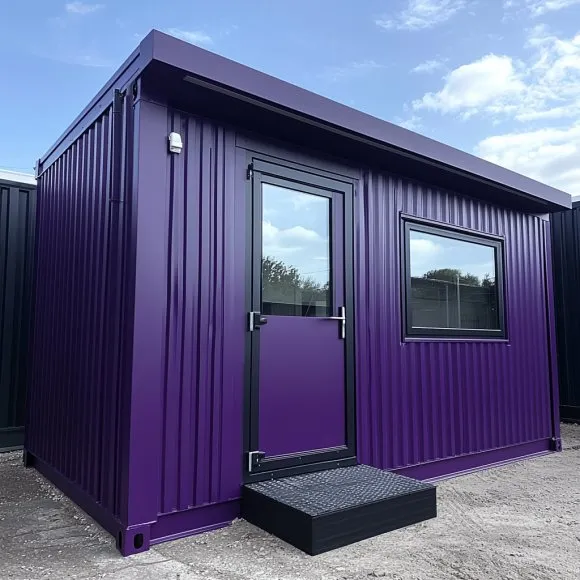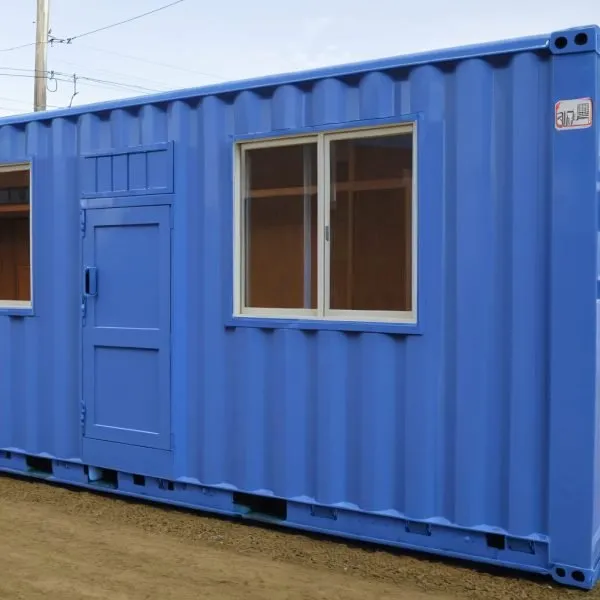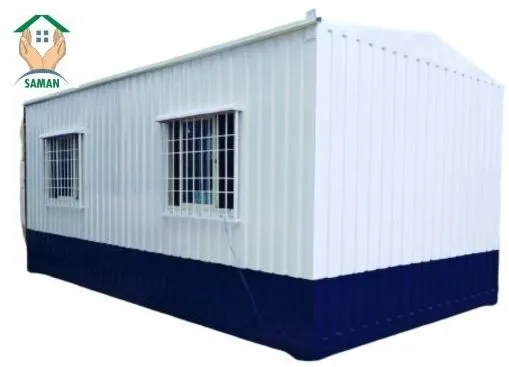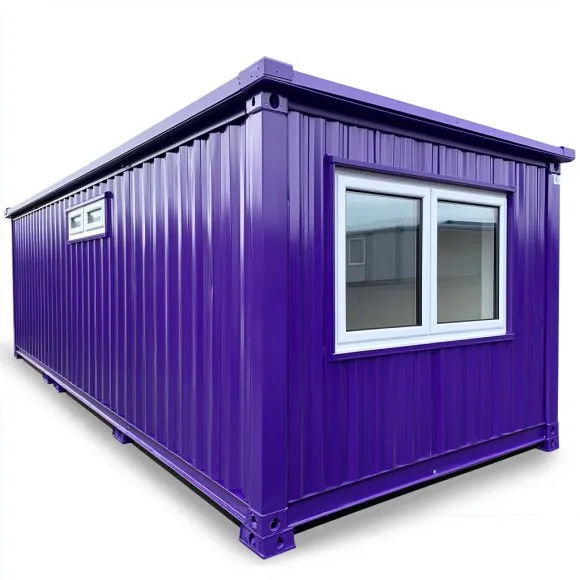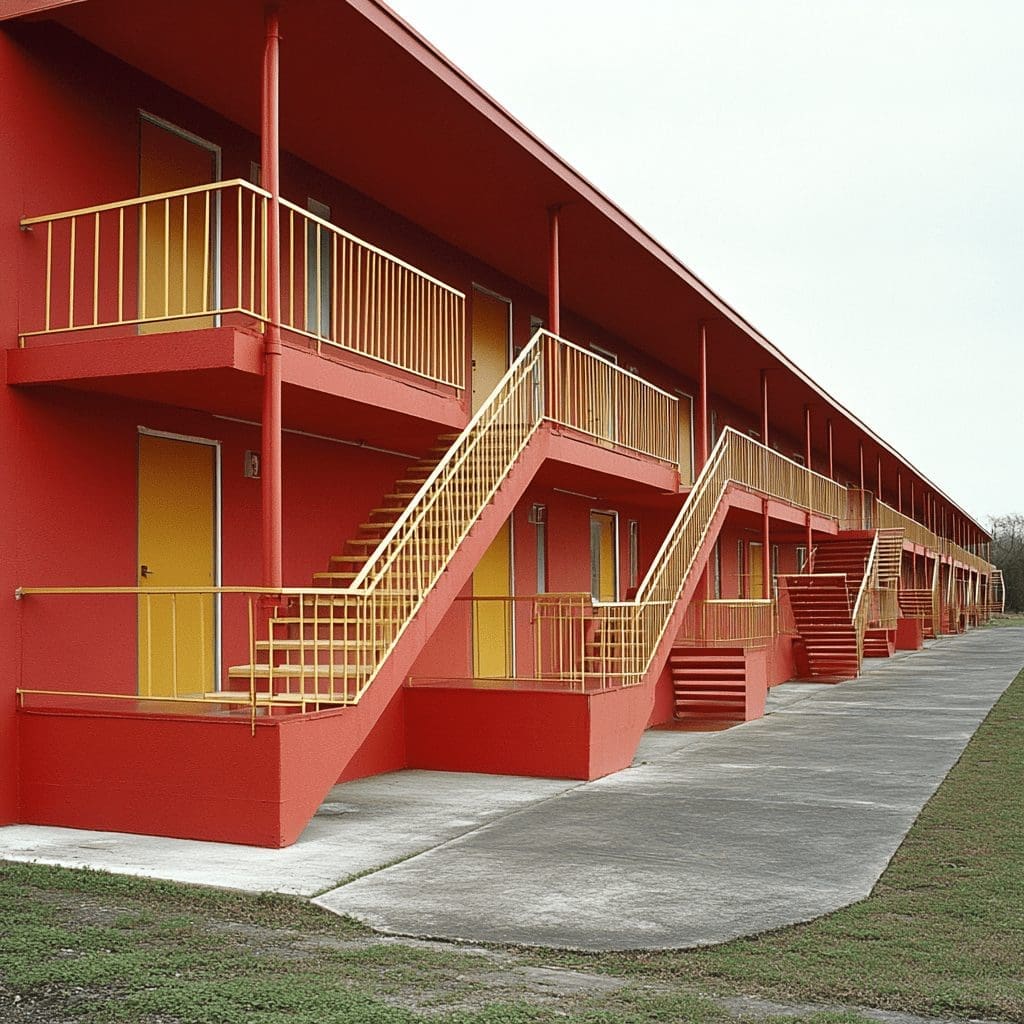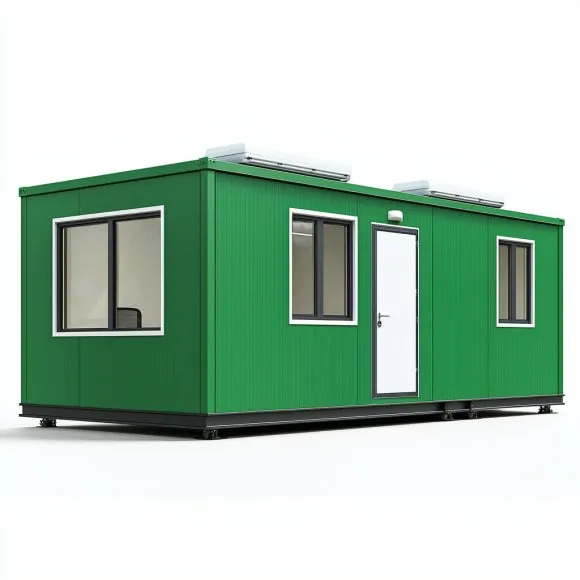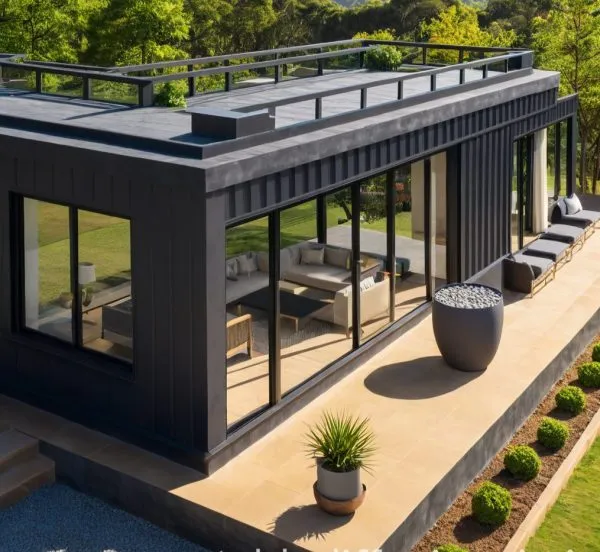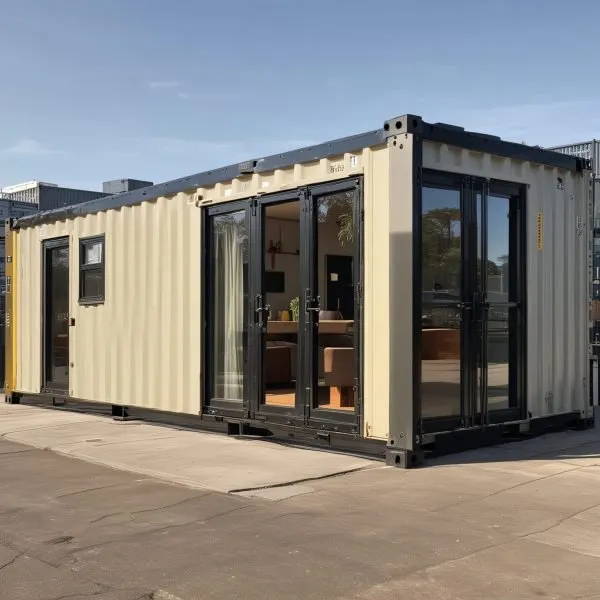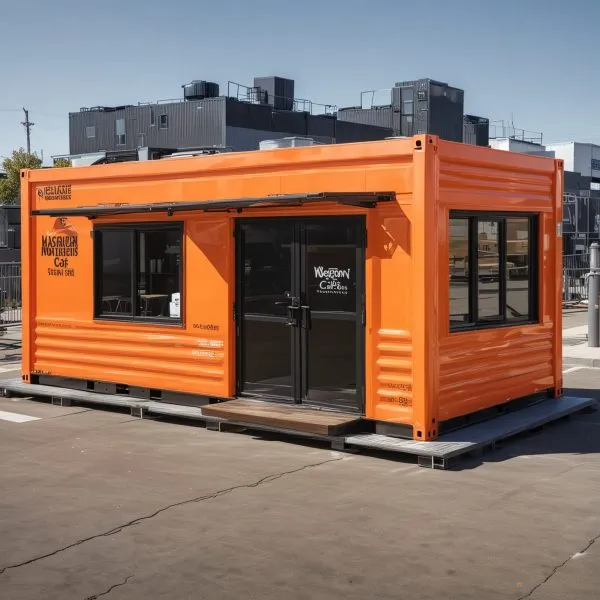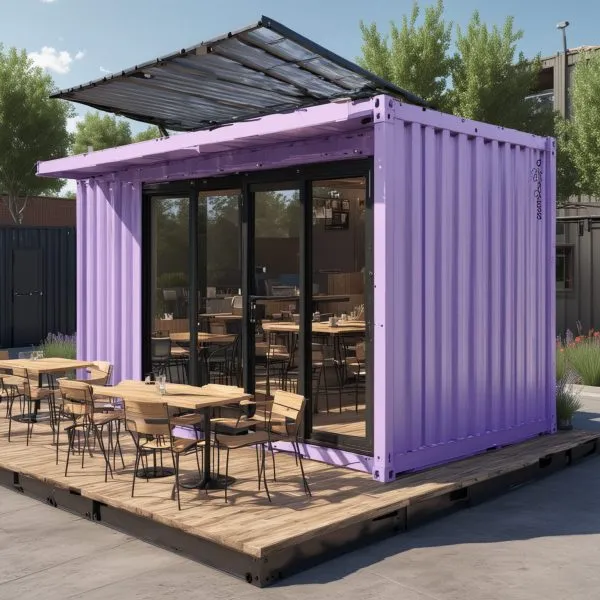Small Wood Cabins: Affordable, Cozy, and Sustainable Living Solutions

Introduction to Small Wood Cabins
Small wood cabins offer a unique and efficient way to live simply while staying connected to nature. With their cozy designs and minimalistic charm, these cabins have become increasingly popular among those looking for affordable, sustainable, and comfortable housing solutions. Whether you’re interested in a small log home for permanent living or a portable home cabin for temporary use, small wood cabins provide a versatile space that can meet a variety of needs. In this blog, we’ll explore the benefits of small wood cabins, what makes them so appealing, and the different styles available, from tiny wood cabin houses to customizable portable small cabins.
What Are Small Wood Cabins?
Small wood cabins are compact, self-contained structures primarily made from wood. They are often used as vacation homes, tiny houses, or even mobile offices. What makes them especially popular is their ability to offer all the essentials of traditional living in a smaller, more affordable footprint. These cabins are designed to maximize space while retaining a cozy atmosphere, making them an ideal solution for people who want to downsize or live more sustainably. Whether it’s a wood cabin house with a traditional aesthetic or a modern, minimalist design, the possibilities are endless for customizing small wood cabins to fit personal needs and style preferences.
Why Choose a Small Wood Cabin?
There are many reasons why people are choosing small wood cabins over traditional homes. One of the biggest advantages is cost-effectiveness. Building a small wood cabin is typically less expensive than constructing a larger home. Additionally, small cabins require less maintenance, lower utility costs, and a smaller environmental footprint, making them an attractive option for environmentally-conscious individuals.
Another benefit of small wood cabins is their versatility. Whether you are looking for a small log home for full-time living, a portable home cabin for temporary use, or a weekend retreat, these cabins are customizable to suit a variety of needs. From simple one-room structures to more elaborate designs with multiple rooms, small wood cabins can be tailored to fit your specific requirements, all while maintaining a small, efficient footprint.
Sustainable Living with Small Wood Cabins
Small wood cabins are an excellent option for those who want to live more sustainably. Wood is a renewable resource, and when sourced responsibly, it offers a more environmentally-friendly building material compared to other options like concrete or steel. Additionally, small wood cabins are designed to be energy-efficient, which reduces the overall environmental impact. Features such as insulation, energy-efficient windows, and solar panel installations are commonly added to small wood cabins, making them an eco-friendly choice for long-term living.
Another sustainable aspect of small wood cabins is their size. Smaller homes use fewer resources to build and maintain, meaning they have a smaller carbon footprint compared to larger homes. For those looking to reduce their environmental impact, a portable log cabin or small wood cabin is an ideal choice.
The Flexibility of Portable Small Cabins
Portable small cabins offer an added layer of flexibility for those who need a mobile living space or temporary accommodation. These cabins are mounted on wheels or have a portable base, allowing them to be easily relocated to different sites. Whether you need a portable cabin for a remote worksite, a guest house, or a temporary living space, portable small cabins can meet your needs.
- Ease of Relocation: A key benefit of portable cabins is that they can be moved to various locations without the need for a permanent foundation. This makes them perfect for those who want to live in different areas or need temporary accommodations.
- Multiple Uses: Portable small cabins are highly versatile. They can serve as vacation homes, mobile offices, or even storage units, offering solutions for different needs in both urban and rural settings.
Conclusion
Small wood cabins offer a blend of comfort, affordability, and sustainability. Whether you’re seeking a tiny log home for year-round living or a portable home cabin for seasonal use, these cabins provide a flexible solution that suits a wide range of purposes. Their low environmental impact, ease of customization, and potential for mobility make them a smart investment for those looking to simplify their lives and reduce their carbon footprint. For more information on how small wood cabins can meet your needs, visit our About Us page.
Designing Your Small Wood Cabins

Designing a small wood cabin allows you to create a space that meets your needs while maintaining a charming, rustic appeal. Whether you’re aiming for a small log home with a traditional design or a modern portable home cabin with minimalist features, the design process is crucial to making the most of the space. In this section, we will explore key considerations when designing your small wood cabin, including layout options, materials, and customization features.
Optimizing the Layout of Your Small Wood Cabin
When designing a small wood cabin, maximizing the use of available space is essential. The key to making the most of a tiny footprint lies in efficient, smart design. Below are some tips to help you plan the layout of your small wood cabin:
1. Open Floor Plans for Spaciousness
Open floor plans are particularly well-suited for small wood cabins as they make the space feel larger and more airy. Combining the living room, kitchen, and dining area into a single open space minimizes walls and maximizes functional space. This layout is ideal for small wood cabins that will be used for vacation homes, tiny living, or small family homes. It’s also easier to maintain and clean compared to divided spaces.
- Living Space Integration: The goal is to create multifunctional areas that can serve more than one purpose. For example, a living area can double as a guest sleeping space with pull-out sofas or foldaway beds.
- Vertical Design: Make use of vertical space with high ceilings or lofted areas for additional sleeping or storage space. Lofted beds or a second floor can maximize space in tiny cabins.
2. Dividing Spaces with Multi-Functional Furniture
In small wood cabins, multi-functional furniture is key to providing the most utility from every square foot. Consider features like fold-down tables, wall-mounted storage, or built-in shelves to make your cabin feel spacious while offering all the necessary comforts.
- Storage Solutions: Utilize hidden compartments, such as under-bed storage or built-in cabinetry, to keep the space organized. Installing shelves along the walls can keep the floor clear for walking and larger furniture pieces.
- Furniture Choices: Opt for lightweight, modular furniture that can be rearranged or folded away when not in use. This allows for flexibility and easy adjustments based on your needs.
Choosing Materials for Your Small Wood Cabin
When selecting materials for your small wood cabin, consider both the aesthetic appeal and the practicality of the materials. Small log homes, in particular, emphasize the use of natural, rustic materials like wood to create a cozy atmosphere. Here are a few material options to consider:
1. Wood and Timber
Wood is the most popular material for small wood cabins, as it is durable, sustainable, and provides a natural, rustic feel. The choice of wood, such as cedar, pine, or oak, will influence the appearance and durability of the cabin. Cedar, for instance, is known for its ability to withstand harsh weather and pests, while pine offers a light, airy feel perfect for smaller cabins.
- Interior Wood Finishes: Inside, wood paneling on walls and ceilings adds to the cabin’s rustic charm. For a modern twist, consider whitewashing or staining the wood for a contemporary look.
- Exterior Finishes: The exterior finish of a small wood cabin can range from natural logs to more polished wood planks, depending on the aesthetic you prefer. Sealing the wood properly will also ensure that your cabin is weather-resistant.
2. Eco-Friendly and Sustainable Materials
If sustainability is a priority, you may want to incorporate eco-friendly materials like reclaimed wood, bamboo flooring, or natural insulation. Insulating your small wood cabin with materials such as sheep wool or cellulose can increase energy efficiency and reduce your environmental footprint.
- Solar Panels and Green Energy: Adding solar panels to your portable home cabin or small log home is an excellent way to reduce energy consumption. Off-grid capabilities allow you to live sustainably while keeping your carbon footprint low.
- Recycled Materials: Look for recycled or repurposed materials for flooring, furniture, and fixtures. This reduces waste and supports environmentally conscious living.
Learn about the sustainable design of tiny portable log cabins in our Tiny Portable Log Cabins Benefits & Uses page.
Customization Features for Your Small Wood Cabin
Customizing your small wood cabin is one of the most exciting aspects of the design process. From the floor plan to the décor, the choices are endless. Here are some popular customization options that can help turn your cabin into a truly personalized living space:
1. Eco-Friendly Features
Incorporating eco-friendly features into your cabin’s design can significantly improve its sustainability. Features such as rainwater harvesting systems, composting toilets, or greywater recycling systems are ideal for small wood cabins that aim to be self-sufficient.
- Solar Power: A solar panel system can be added to your cabin to power lights, appliances, and other electrical needs. For those off the grid, this can eliminate the need for external power sources, making your small wood cabin energy independent.
- Energy-Efficient Windows and Doors: Installing double-glazed windows and energy-efficient doors helps keep the cabin warm in winter and cool in summer, reducing your reliance on heating and air conditioning.
2. Interior and Exterior Aesthetic Customizations
Customize your cabin’s interior with different finishes, lighting, and furniture to suit your personal taste. For example, if you prefer a more modern aesthetic, opt for minimalist décor, white or neutral walls, and sleek furniture pieces. Alternatively, if you love a more rustic and cozy feel, use reclaimed wood furniture, patterned rugs, and vintage lighting.
- Natural Light: Maximize natural light in your small log home with strategically placed windows. Skylights or large windows allow for plenty of sunlight to flow in, making the space feel more expansive and connected to the outdoors.
- Exterior Design: The exterior design of your wood cabin house can be customized to reflect your personal style, whether you prefer a traditional log cabin design or a more contemporary look with clean lines and minimalistic features.
Want to make your little log home unique? Check out our Little Log Houses Benefits & Uses page for more customization ideas.
Conclusion
Designing your small wood cabin is a personal and exciting process that allows you to create a space that fits your needs and style preferences. From optimizing the layout to selecting sustainable materials and adding eco-friendly features, there are numerous ways to customize your cabin to suit your lifestyle. Whether you choose a small log home, a wood cabin house, or a portable home cabin, your tiny wood cabin can become a cozy, functional, and environmentally friendly living space. For more information on building your ideal small wood cabin, visit our About Us page.
Size and Space Considerations for Small Wood Cabins
When planning for a small wood cabin, one of the most important factors to consider is the size of the cabin and how to efficiently use the available space. Whether you’re thinking about a small log home, a wood cabin house, or a portable home cabin, each option comes with its own set of space limitations and opportunities. In this section, we’ll discuss ideal cabin sizes, space-saving tips, and how to maximize your tiny cabin for both comfort and functionality.
Ideal Size for Small Wood Cabins
The size of your small wood cabin will largely depend on your personal needs and the purpose of the cabin. Tiny homes generally range in size from 100 to 600 square feet, but smaller options under 200 square feet are also available. Here’s how to think about cabin sizes based on use:
1. Weekend or Vacation Retreats
If your goal is to have a small wood cabin as a weekend getaway or vacation retreat, a cabin size of 150 to 300 square feet is typically sufficient. These cabins are designed to offer all the necessary amenities in a compact space, without being overwhelming. You can fit a small kitchen, bathroom, and living area within this size, while still maintaining a cozy and functional living environment.
- Compact Retreats: A 150-250 square foot cabin offers an open floor plan, perfect for a single person or a couple looking for a minimalist lifestyle. Lofted beds or multi-functional furniture are often included to make the most of the limited space.
2. Permanent Living
For full-time living in a small log home or wood cabin house, you’ll likely need a bit more space. A cabin size of 400-600 square feet is more comfortable for full-time use, providing more room for larger furniture, dedicated sleeping areas, and additional storage. These cabins can still feel cozy and compact while offering a higher level of functionality.
- Long-Term Living: A 500-600 square foot cabin can include a separate bedroom, kitchen, living room, and bathroom. If you plan to live full-time, this additional space makes daily living more comfortable without compromising the benefits of tiny living.
3. Portable Homes for Mobility
For those seeking a portable home cabin that can be moved easily, the cabin’s size may range from 100 square feet to 400 square feet, depending on how much space you need. These portable homes are perfect for those who prefer flexibility and want the option to relocate the cabin at any time. Smaller portable cabins are easy to transport and can be used for temporary living, while larger ones offer more comfort for long-term stays.
- Compact and Mobile: The 100-200 square foot range for portable cabins is ideal for quick setups at temporary sites, while 300-400 square foot portable homes are more suited for long-term use, with features like built-in furniture, a kitchen, and a bathroom.
Visit the Portable Cabins for Sale in Bangalore page to explore cost-effective cabin solutions.
Maximizing Space in Small Wood Cabins
Making the most out of your small wood cabin comes down to how you organize and use your space. Whether you opt for a small log home or a more modern portable small cabin, here are some space-saving strategies to help you get the most functionality from your cabin:
1. Open Floor Plans
An open floor plan is one of the best ways to create a sense of space in a small wood cabin. By reducing the number of walls and keeping the design as open as possible, you allow natural light to flow throughout the cabin, making it feel larger and more airy. This layout also makes it easier to combine living areas like the kitchen, dining, and lounge into one versatile space.
- Combining Rooms: Instead of having separate rooms for each function, try combining areas like the kitchen and living room into a single multifunctional space. This will allow you to have an open, spacious feel while keeping the cabin functional.
2. Vertical Design for Loft Space
Maximizing vertical space is a common trick in small wood cabins. Loft areas can serve as sleeping spaces or storage areas, freeing up the main floor for other uses. Lofted beds or mezzanine levels are particularly effective in cabins with high ceilings, where you can create a second floor to maximize living space.
- Lofted Sleeping Area: A lofted bed can save considerable space by raising the sleeping area off the ground, providing more room for other functions on the main floor, such as the kitchen or seating area.
- Storage in High Spaces: Built-in shelves or storage units above the living space can further reduce clutter and allow for more efficient use of your cabin.
3. Multi-Functional Furniture
Incorporating multi-functional furniture is essential in small wood cabins. Furniture that can serve multiple purposes helps maximize space without compromising comfort. For example, a portable home cabin might feature a fold-out bed that doubles as a couch, or a dining table that converts into a work desk.
- Space-Saving Furniture: Look for pieces like wall-mounted desks, fold-down tables, and chairs that stack to save space. Using furniture that can be easily moved or stored away will keep your cabin organized and functional.
4. Efficient Use of Storage
Storage is a critical factor in small log homes and other small cabins. Maximizing the space available for storage ensures that your cabin remains organized and clutter-free. Look for ways to integrate storage into everyday furniture, such as under-bed drawers, built-in cabinets, and over-the-door organizers.
- Built-In Storage: Many small wood cabins include built-in furniture that doubles as storage. This could include benches with hidden compartments, cabinets under the staircase, or storage shelves above countertops.
Conclusion
The size of your small wood cabin plays a significant role in determining how comfortable and functional the space will be. By carefully selecting the right size and using clever space-saving designs, your small log home or portable home cabin can be transformed into a highly efficient and cozy living space. Whether you’re interested in a small, compact getaway or a full-time residence, the design and size of your tiny cabin will determine how well it suits your lifestyle needs. For more information on maximizing your small wood cabin’s design and features, visit our About Us page.
Cost of Small Wood Cabins: What You Should Know

When considering a small wood cabin, one of the most important factors to account for is the cost. While small wood cabins offer a more affordable option than traditional homes, the total price can still vary based on size, materials, design, and custom features. Understanding the costs involved in building or purchasing a small wood cabin is essential for budgeting and planning. In this section, we’ll break down the various costs associated with small wood cabins, including initial expenses, ongoing maintenance, and additional considerations.
Initial Costs of Small Wood Cabins
The initial cost of a small wood cabin depends on several factors, including its size, design complexity, and the materials used. Smaller cabins typically cost less, but customization options, such as energy-efficient features, premium finishes, and additional amenities, can increase the price. Here are some of the key factors that influence the cost of building or purchasing a small wood cabin:
1. Size and Layout
The size of the cabin plays a significant role in its cost. Smaller cabins, like a small log home or wood cabin house, are more affordable, but larger or more complex designs can drive up the price. If you’re planning on a portable home cabin, its size will also affect transportation and installation costs.
- Small and Compact Models: A basic small wood cabin can cost between ₹2,00,000 and ₹5,00,000 for sizes around 150-300 square feet. These cabins typically feature open floor plans and minimal interior customizations.
- Medium-Sized Cabins: For a larger cabin around 400-600 square feet, costs range from ₹5,00,000 to ₹10,00,000. These cabins may include separate rooms, upgraded insulation, and additional features like plumbing and electricity.
2. Materials and Construction
The materials used to construct a small wood cabin are a major factor in the overall cost. While wood is generally affordable, the type of wood you choose, as well as any additional finishes, can drive up the price. High-quality wood, such as cedar or redwood, tends to be more expensive than standard pine or spruce.
- Premium Materials: Choosing sustainable or premium wood materials can increase the cabin’s price, but these materials often provide better durability and aesthetic appeal.
- Custom Finishes: The cost of custom finishes, such as flooring, cabinetry, and countertops, can add to the initial price of your small wood cabin. Opting for higher-end finishes or eco-friendly materials can further increase the cost.
Additional Costs to Consider
In addition to the base cost of purchasing or building a small wood cabin, there are several other expenses that should be considered when budgeting for your new home.
1. Site Preparation and Foundation
Preparing the site for your small log home or portable cabin is a critical step in the process. If your chosen land requires leveling, clearing, or excavation, these costs should be factored in. Foundation costs vary depending on the type of foundation you choose for your cabin.
- Foundation Options: For a more temporary or portable structure, a gravel pad or pier foundation may be sufficient. For a permanent wood cabin house, a concrete slab or more substantial foundation may be required, which will add additional costs (approximately ₹20,000-₹1,00,000 depending on size and complexity).
2. Delivery and Installation
For portable small cabins, there may be delivery and installation fees to consider. Transporting a portable home cabin to your desired location can be costly, especially if it’s a larger unit or needs to be relocated over long distances.
- Transportation Fees: Delivery fees for small cabins typically range from ₹10,000 to ₹50,000, depending on distance, the cabin’s size, and the logistics involved.
- Installation Costs: While some small cabins may be easy to install yourself, others may require professional installation, especially if plumbing, electrical wiring, or other features are involved. Professional installation can add ₹20,000 to ₹50,000 to the cost.
3. Utility Hookups
If your small wood cabin is being used for full-time living, you will likely need to hook up utilities such as electricity, water, and sewage. These hookups can add additional costs to your cabin project, depending on the location and the availability of nearby services.
- Off-Grid Solutions: For those who want to live off the grid, installing solar panels, wind turbines, or rainwater harvesting systems can be an investment that pays off over time. Solar panels, for example, can cost ₹50,000 to ₹2,00,000, depending on the system size and setup.
- Traditional Utilities: If you plan to connect your cabin to municipal utilities, the cost of bringing water, electricity, and sewage systems to your cabin may range from ₹50,000 to ₹2,00,000 depending on the distance to the nearest hookups.
Ongoing Maintenance and Running Costs
Once your small wood cabin is built and operational, there are ongoing costs to consider, especially if you plan to use it as a full-time residence. These include maintenance, utilities, and other living expenses.
1. Maintenance Costs
Maintaining your small wood cabin is crucial for its longevity. While wood is a durable material, it requires regular maintenance to ensure it remains in good condition.
- Exterior Care: Periodically resealing the exterior, cleaning the roof, and protecting the wood from the elements will help your cabin last longer. Budgeting around ₹5,000 to ₹15,000 annually for maintenance can help prevent major repairs down the line.
- Interior Upkeep: Inside the cabin, you may need to maintain plumbing, electrical systems, and furniture. Regular cleaning and upkeep can help extend the lifespan of these features.
2. Utility Bills
Utility bills for small log homes are typically lower than those for larger homes, as the smaller size leads to reduced energy usage. However, the cost will vary based on the type of heating, cooling, and electrical systems used.
- Energy-Efficient Living: Installing energy-efficient appliances, LED lights, and insulation can help reduce monthly utility bills. Small wood cabins are ideal for energy efficiency, as they require less power to heat or cool.
Conclusion
The cost of a small wood cabin can vary depending on a number of factors, including size, design, materials, and additional features. While these cabins are generally more affordable than traditional homes, it’s important to account for all potential costs, including site preparation, utilities, and ongoing maintenance. Whether you’re considering a small log home for full-time living or a portable home cabin for a seasonal retreat, small wood cabins offer a cost-effective and eco-friendly housing solution. For more details on how to budget for your tiny wood cabin, visit our About Us page.
Portable Home Cabins: The Ultimate in Mobility
Portable home cabins offer the perfect solution for those who need flexible living spaces or temporary accommodation without sacrificing comfort. Whether you are looking for a small wood cabin to use as a mobile office, a guest house, or a cozy getaway, portable home cabins provide the mobility and convenience that traditional homes cannot match. In this section, we will explore the benefits, uses, and features of portable home cabins, and how they offer an ideal solution for a variety of living and working scenarios.
Check out the Cabins on Wheels Benefits and Options page for portable and flexible cabin options.
What Is a Portable Home Cabin?
A portable home cabin is a self-contained structure that is designed to be easily relocated. Unlike traditional homes that are fixed to a single location, portable cabins can be moved to different sites, offering the flexibility to live or work in multiple locations. These cabins are typically mounted on wheels or a movable base, which allows them to be transported from one place to another.
- Versatility: Portable home cabins are versatile and can be used for various purposes, from full-time living to temporary office spaces or vacation homes. Depending on your needs, you can find cabins that are small and compact or larger models with additional features.
- Ease of Relocation: One of the biggest benefits of portable cabins is the ability to relocate them easily. Whether you need to move your small log home to a new location or take your wood cabin house on the road, portability ensures that you have flexibility in your living arrangements.
Benefits of Portable Home Cabins
There are numerous advantages to choosing a portable home cabin over traditional housing options. Here are the top benefits that make these cabins increasingly popular:
1. Mobility and Flexibility
The greatest benefit of portable home cabins is their mobility. You can move your cabin to different locations without having to invest in permanent real estate. This is particularly useful for people who need to relocate frequently, such as those working in remote areas, traveling professionals, or those simply looking for a temporary living space.
- Flexible Living: If you like to travel or move between seasonal locations, a portable home cabin provides a hassle-free solution. You can bring your home with you wherever you go, whether it’s a serene mountain retreat or a beachfront escape.
- Temporary Housing: Portable cabins are perfect for temporary housing needs. Whether you’re building a permanent home and need interim accommodations, or you require a guest house or rental property, portable cabins offer an easy, flexible solution.
2. Cost-Effectiveness
Compared to traditional homes, portable home cabins are significantly more affordable. The costs of construction, site preparation, and utilities are generally lower than those associated with conventional houses. Additionally, portable cabins require fewer resources to build, which makes them a more budget-friendly option for those looking to save on housing costs.
- Lower Initial Costs: Whether you’re purchasing a small wood cabin or a larger model, the upfront cost of a portable home cabin is much lower than a traditional house. The smaller size and simplified construction processes result in a lower price tag.
- Reduced Ongoing Expenses: Portable cabins also offer long-term savings. Since they are smaller and more energy-efficient, they cost less to maintain and operate, with lower utility bills and reduced maintenance needs.
3. Sustainability and Environmental Benefits
For those looking to minimize their environmental impact, portable home cabins offer a sustainable option. These cabins are often built with eco-friendly materials, and many come equipped with green features like solar panels, rainwater harvesting systems, and energy-efficient appliances.
- Eco-Friendly Materials: Many portable cabins are built using sustainable, renewable resources like wood, which is not only durable but also has a lower environmental impact than many other building materials.
- Energy Efficiency: The compact size of portable small cabins makes them naturally energy-efficient. Additionally, many cabins are designed with high-quality insulation, energy-efficient windows, and renewable energy systems like solar power to further reduce energy consumption.
4. Versatile Uses and Customization Options
Portable home cabins can be customized for a variety of uses. Whether you’re looking for a small log home as a vacation retreat, a guest house, a mobile office, or even a rental property, these cabins can be tailored to meet your specific needs.
- Custom Features: Portable cabins can be designed with a variety of interior and exterior features, including kitchens, bathrooms, and storage spaces. Customization options allow you to adapt your cabin to fit your lifestyle and preferences.
- Multiple Applications: These cabins are ideal for a wide range of uses. Whether you need a temporary place to stay, a full-time home, or a workspace, portable home cabins offer flexibility that traditional housing options simply cannot match.
Explore more on portable log cabins in our Portable Log Cabins Benefits & Uses page.
The Many Uses of Portable Home Cabins
The versatility of portable home cabins makes them an excellent choice for various applications. Below are some of the most popular uses for these movable homes:
1. Vacation Homes and Getaways
Portable cabins can serve as the perfect vacation home or weekend getaway. Their mobility allows you to take your cabin to different scenic locations, giving you the freedom to experience nature while still having the comforts of home. Whether it’s by the beach, in the mountains, or by a lake, portable cabins provide an affordable and cozy retreat.
2. Mobile Offices
For remote workers, entrepreneurs, or businesses that need a mobile workspace, portable home cabins can be converted into functional mobile offices. These cabins offer a quiet and private space to work without leaving the comfort of home. They can be equipped with electrical outlets, internet connections, and even air conditioning or heating systems for year-round use.
3. Guest Houses
Need extra space for visitors? A portable cabin can serve as a guest house, providing your family and friends with a comfortable, private space to stay. This is a great solution for families who host guests frequently but don’t have enough space in their main home.
4. Storage Solutions
In addition to living spaces, portable cabins can also be used for storage. Whether you need extra storage on your property or a mobile storage unit for a construction site or business, portable cabins provide secure, weatherproof storage options that can be easily moved when needed.
Explore sustainable off-grid living options on our Pop-Up Cabin Benefits Flexible Affordable page.
Conclusion
Portable home cabins offer flexibility, affordability, and eco-friendliness for a variety of living and working needs. Whether you need a small wood cabin for temporary use, a small log home for full-time living, or a mobile office, these cabins provide the ideal solution. Their ability to be easily relocated, combined with their sustainability and cost-effectiveness, makes them an attractive option for anyone looking for a flexible, low-maintenance housing solution. For more information about how portable cabins can meet your needs, visit our About Us page.
Building and Installing Your Small Wood Cabin

Building and installing a small wood cabin can be an exciting and rewarding project. Whether you’re looking for a small log home, a wood cabin house, or a portable home cabin, the process can vary depending on the design, location, and features you choose. In this section, we’ll break down the essential steps for building and installing your small wood cabin, from site preparation to the final setup, ensuring your cabin is ready for use.
Site Selection and Preparation
Before you can start building your small wood cabin, it’s crucial to choose the right location. The site you select will influence the foundation, utility hookups, and the overall accessibility of your cabin. Here are a few important considerations when choosing a site for your wood cabin house or small log home:
1. Level Ground
Your cabin needs to sit on level ground to ensure stability and prevent structural damage over time. If the land is uneven, you may need to level it before beginning construction. Site preparation can include grading, excavation, or bringing in fill material to level the ground.
- Access for Transport: If you’re opting for a portable small cabin or portable home cabin, make sure the location is accessible for trucks or cranes that will transport your cabin to the site. Some sites may require road improvements to accommodate delivery vehicles.
2. Foundations and Footings
The type of foundation for your small wood cabin will depend on whether it’s intended to be permanent or movable. Permanent foundations, like concrete slabs or pier foundations, are necessary for small log homes or larger wood cabin houses.
- Pier Foundations: For a small wood cabin or portable home cabin, a pier foundation may be enough, as it keeps the structure off the ground, providing ventilation while also being cost-effective.
- Concrete Slab Foundations: If your cabin is going to be a permanent structure, you might opt for a concrete slab foundation, which provides a solid base and helps to minimize pests or moisture issues.
Building Your Small Wood Cabin
Once the site is prepared and the foundation is in place, the next step is the construction of your small wood cabin. Whether you plan to build the cabin yourself or hire a contractor, here’s what you need to know about the process:
1. Framing and Structure
Building the frame is the first step in constructing your cabin. The frame is the skeleton of the cabin, providing support for the walls, roof, and other components. If you’re building a wood cabin house, you’ll begin with wood framing, which is lightweight yet strong enough to support the structure.
- Log Construction: For those looking to create a small log home, the process may involve stacking logs, which will serve as both the walls and structural support. Logs are often treated for durability and resistance to pests and weather.
2. Roofing and Insulation
Once the frame is up, you’ll install the roof. The type of roofing material will vary based on your budget and style preferences, ranging from metal panels to traditional shingles. Insulation is also crucial, especially if you plan to use your small wood cabin year-round.
- Roof Materials: Metal roofs are durable and weather-resistant, while shingles may offer a more traditional look. Your roofing material should be chosen based on local weather conditions and the cabin’s intended use.
- Insulation: Proper insulation helps to keep your small wood cabin comfortable in both hot and cold climates. Consider using eco-friendly insulation materials such as cellulose, cotton, or wool for a more sustainable approach.
3. Interior Setup and Utilities
The interior of your small log home or wood cabin house can be customized to suit your needs. From basic furniture to fully equipped kitchens and bathrooms, the interior setup is where you can personalize your cabin to fit your lifestyle.
- Plumbing and Electrical: If your small wood cabin is going to be a permanent living space, you’ll need to install plumbing, electrical wiring, and heating systems. In some cases, you may opt for off-grid solutions, such as composting toilets or solar panels.
- Interior Design: From the flooring to wall treatments, there are plenty of design choices to make. Choose materials that are durable and sustainable, such as reclaimed wood or bamboo, for a rustic yet eco-friendly feel.
Installing Your Small Wood Cabin
After construction, it’s time to install your small wood cabin at its final location. If you’re building a portable home cabin, the installation process is relatively simple, as these cabins can be delivered and placed on the prepared site. Here’s what you need to know about the installation process:
1. Transporting the Cabin
If you’ve built a portable home cabin, you will need to transport it to the site. For larger small wood cabins, this step may involve moving the cabin using a flatbed truck or trailer. Ensure that the path to the installation site is clear and that the cabin can be easily maneuvered into place.
- Hiring Professionals: For larger or more complex installations, it’s best to hire professional movers who specialize in transporting small wood cabins or portable cabins. They can ensure that the cabin is transported safely without damage.
2. Securing the Cabin
Once the cabin is in place, it needs to be properly anchored or set on its foundation. If you’ve chosen a small wood cabin with a permanent foundation, securing the cabin will involve fixing it to the foundation to prevent movement, especially in high winds or storms.
- Anchoring Portable Cabins: For portable small cabins, the anchoring process is more straightforward. However, it’s important to secure the cabin properly to prevent it from shifting, especially if it’s located in an area prone to extreme weather.
Working with Professional Installers
If you’re not comfortable with handling the construction or installation process yourself, you can always hire a professional builder or installer to take care of the details. Many companies offer small wood cabins for sale and provide installation services as part of the package.
- Choosing a Reliable Installer: Look for contractors with experience in building and installing small log homes or portable home cabins. They can ensure the cabin is set up correctly and meets local building codes and regulations.
Maintenance and Upkeep for Small Wood Cabins
Owning a small wood cabin comes with the responsibility of regular maintenance to ensure it remains functional and retains its aesthetic appeal over time. Whether it’s a small log home or a portable home cabin, proper care will help you extend the life of your cabin, reduce costly repairs, and keep it looking its best. In this section, we will cover essential maintenance tasks for small wood cabins and provide tips for long-term upkeep.
General Maintenance for Small Wood Cabins
Wood cabins are durable structures, but they require regular attention to keep them in top condition. Small wood cabin houses and small log homes are particularly vulnerable to environmental factors such as weather changes, humidity, and pests. Here’s a breakdown of the general maintenance tasks for your small wood cabin:
1. Exterior Care: Protecting Your Cabin from the Elements
The exterior of your small wood cabin is exposed to the elements and needs to be protected regularly to maintain its strength and appearance. Proper care involves resealing, painting, and protecting the wood from damage caused by rain, snow, and sunlight.
- Resealing and Staining: Every few years, you should reseal or restain the wood exterior of your small log home to protect it from water damage and decay. Wood stains also enhance the cabin’s appearance, giving it a rich, natural look.
- Cleaning and Pressure Washing: Clean the exterior regularly to remove dirt, mold, or mildew that can accumulate over time. Pressure washing is a great option for removing stubborn dirt, but be careful not to damage the wood by using too much pressure.
- Weatherproofing: Ensure that all windows and doors are tightly sealed to prevent drafts. Installing weatherproofing materials can help your small wood cabin stay energy-efficient and protect against moisture, which can lead to wood rot.
2. Roof Maintenance: Preventing Leaks and Damage
The roof is one of the most vulnerable parts of any cabin, as it’s directly exposed to weather conditions. Routine inspections and maintenance are essential for preventing leaks and maintaining a dry, comfortable living space inside.
- Inspect for Damage: Regularly check your roof for damage, especially after heavy rain, snow, or storms. Look for loose shingles or tiles, cracks, or signs of wear. Addressing any issues early can prevent leaks and other costly repairs.
- Cleaning Gutters: Clean gutters and downspouts to prevent water buildup, which can lead to water damage on the roof and in the cabin’s walls. Clogged gutters can also cause water to back up, potentially damaging the roof structure.
3. Pest Prevention: Keeping Your Cabin Safe
Wooden structures, particularly small log homes, are susceptible to pests like termites, carpenter ants, and rodents. Preventing pest infestations is a key part of cabin maintenance.
- Inspect for Pests: Regularly inspect the wooden beams, logs, and foundation of your wood cabin house for signs of termites or other insects. Look for holes, tunnels, or wood that sounds hollow when tapped.
- Treating the Wood: Consider using natural pest-repelling treatments such as cedar oil or borate treatments to protect your cabin’s wooden surfaces. Additionally, seal any cracks or gaps around windows, doors, and the foundation where pests could enter.
Interior Care for Small Wood Cabins
While the exterior of your small wood cabin is exposed to more wear and tear, the interior also requires maintenance to ensure comfort and functionality. Proper care of the interiors can make a big difference in your cabin’s longevity and livability.
1. Cleaning and Preserving Wood Surfaces
Inside your small log home, the wood surfaces should be cleaned regularly to maintain their beauty. Dust and dirt can accumulate on wooden floors, walls, and ceilings, so it’s important to use appropriate cleaning methods to protect the wood.
- Vacuum and Dust: Regularly vacuum carpets and rugs, and dust furniture and wooden surfaces. For wooden floors, use a soft broom or microfiber mop to remove debris without scratching the wood.
- Wood Preservation: To preserve the wood’s natural finish, avoid using harsh chemicals or abrasive cleaners. Use wood-friendly cleaning products, and periodically apply wood polish to enhance the natural sheen and protect the surface from wear.
2. Checking Plumbing and Electrical Systems
If your small wood cabin is equipped with plumbing and electrical systems, regular checks are necessary to ensure everything is functioning properly. Leaky pipes, clogged drains, or faulty electrical systems can lead to bigger issues down the road.
- Inspecting Plumbing: Regularly check pipes for leaks, especially in cold weather, as frozen pipes can burst and cause significant damage. Test faucets, showers, and toilets to ensure there are no blockages or malfunctions.
- Electrical Safety: Periodically inspect the electrical wiring for signs of wear or fraying. Make sure all appliances, outlets, and light fixtures are working properly. If you notice anything unusual, call a licensed electrician for repairs.
3. Heating and Cooling Systems
Heating and cooling are essential for maintaining comfort in your small wood cabin, especially in extreme climates. Routine maintenance of your cabin’s heating and cooling systems will help them operate efficiently and prolong their lifespan.
- Wood Stove Maintenance: If your small log home uses a wood stove or fireplace, clean the chimney and stovepipes regularly to remove soot and prevent the buildup of creosote, which can cause fires.
- Air Conditioning and Heating: For cabins with air conditioning or heating systems, ensure filters are replaced regularly and that the system is checked for efficiency.
Seasonal Maintenance Tips for Small Wood Cabins
Seasonal changes require specific maintenance tasks to keep your small wood cabin in optimal condition year-round. Here are some important seasonal maintenance tips for both small log homes and portable small cabins:
- Winterizing: Before the cold weather sets in, make sure that the cabin is well-insulated and draft-proof. Disconnect and drain outdoor plumbing to prevent freezing pipes, and check heating systems to ensure they are working efficiently.
- Spring and Fall Maintenance: During the warmer months, clean the gutters, inspect the roof, and check for any damage caused by winter storms. Spring is also a good time to treat the exterior wood with a fresh coat of stain or sealant.
Portable Home Cabins: The Benefits of Flexibility

Portable home cabins offer a unique combination of mobility, convenience, and affordability that traditional homes simply cannot match. Whether you’re looking for a small wood cabin for temporary use, a small log home for seasonal living, or a wood cabin house to serve as a mobile office, portable cabins provide a flexible solution for various living and working needs. In this section, we’ll explore the key benefits of choosing a portable home cabin and how this versatile housing option can improve your lifestyle.
What Makes Portable Home Cabins Unique?
Portable home cabins are designed to be easily moved from one location to another, offering a level of flexibility that fixed homes can’t provide. Unlike traditional homes, which are built on permanent foundations, portable cabins are mounted on wheels or trailers, allowing them to be relocated with minimal effort. This mobility makes them ideal for a wide range of uses, including:
- Temporary Housing: Whether you’re building a permanent home or need a place to stay while traveling, a portable small cabin offers a quick and efficient solution for temporary living. You can easily relocate it to different locations as needed.
- Mobile Offices: For business owners or remote workers, portable cabins can be converted into mobile offices, allowing you to work from anywhere. With modern amenities and enough space for equipment, these cabins are perfect for creating a dedicated workspace on the go.
- Vacation Homes: Portable cabins are also an excellent option for vacation homes. You can place your cabin in scenic locations, enjoying the flexibility of moving it whenever you wish while still having a comfortable place to stay.
The Benefits of Flexibility with Portable Home Cabins
The ability to move your cabin is the biggest advantage of opting for a portable home cabin. But that’s not the only benefit these cabins offer. Here are some other reasons why portable cabins are gaining popularity:
1. Cost-Effectiveness
Compared to traditional homes, portable cabins are significantly more affordable. The cost of building or buying a small wood cabin on a permanent foundation can be high, especially with the price of land and materials. Portable cabins, on the other hand, offer an affordable housing option that requires fewer resources to build and maintain.
- Lower Construction Costs: Portable home cabins require less labor and materials to construct than traditional homes, which means lower upfront costs.
- Reduced Land Costs: Since portable cabins are mobile, you don’t need to purchase expensive land or pay for a permanent foundation. You can place your cabin on rented land, a temporary site, or even on property you already own.
2. Environmental Benefits
For those looking to reduce their environmental impact, portable small cabins provide an eco-friendly solution. These cabins are typically smaller in size, which means less energy is needed to heat and cool the space. Additionally, many portable cabins are built using sustainable materials and can be outfitted with eco-friendly features such as solar panels or composting toilets.
- Energy Efficiency: Due to their small size, portable cabins require less energy to operate. Many models are designed with energy-efficient insulation, windows, and appliances to further reduce energy consumption.
- Sustainable Materials: Many portable cabins are constructed with environmentally friendly materials, such as reclaimed wood or eco-friendly insulation, making them a greener option compared to traditional homes.
3. Multi-Use Applications
Portable cabins can be used for a wide variety of purposes, which adds to their flexibility. Whether you need a small wood cabin for full-time living, a guest house, or a temporary space for a construction project, portable cabins can adapt to your needs.
- Guest Houses: If you frequently host visitors, a small log home or portable cabin can serve as a guest house, providing extra space without the need for a permanent addition to your main house.
- Storage Solutions: Portable cabins are also ideal for use as storage units. Whether you need a place to store tools, equipment, or personal belongings, these cabins can be customized for secure and weatherproof storage.
- Event Spaces: For those in need of extra space for events, a portable cabin can serve as a temporary venue. With the right layout, portable cabins can be transformed into event spaces for weddings, parties, or gatherings.
4. Minimalistic and Comfortable Living
One of the defining features of a portable home cabin is its ability to offer comfortable living without unnecessary space or clutter. Many people today are opting for minimalist lifestyles, and portable cabins perfectly fit this trend. With thoughtful design and smart use of space, these cabins can provide everything you need in a compact package.
- Efficient Layouts: Compact, open floor plans maximize space and minimize wasted square footage. Foldable furniture, hidden storage, and multifunctional spaces allow you to make the most of every corner of your cabin.
- Comfortable Amenities: Despite their small size, small wood cabins can be equipped with all the amenities needed for comfortable living, such as a full kitchen, bathroom, and sleeping area.
5. Ideal for Remote Living
For those seeking a quiet, off-the-grid lifestyle, portable home cabins are the perfect choice. These cabins can be set up in remote locations, allowing you to escape the hustle and bustle of city life and enjoy the peace and solitude of nature.
- Off-Grid Living: Many portable cabins are designed for off-grid living, equipped with solar panels, composting toilets, and rainwater harvesting systems. This allows you to live independently, without the need for connection to municipal utilities.
- Self-Sufficiency: If you enjoy homesteading or want to live in a self-sufficient manner, a portable home cabin can be outfitted to meet all your needs. Grow your own food, generate your own power, and live sustainably without relying on external resources.
Ideal Uses for Small Wood Cabins
Small wood cabins are incredibly versatile structures that can be used for a wide range of purposes. Whether you’re looking for a small log home, a wood cabin house, or a portable home cabin, these cabins offer a perfect solution for those who need a compact, functional, and affordable space. In this section, we will explore some of the most popular uses for small wood cabins and how they can serve as practical solutions for your needs.
1. Vacation Homes and Getaways
One of the most common uses for small wood cabins is as a vacation home or weekend getaway. With their rustic charm and cozy interiors, small wood cabins offer a perfect retreat from the hustle and bustle of everyday life. You can place your small log home in a peaceful, scenic location, whether it’s in the mountains, by the beach, or in the woods, and enjoy a tranquil, private getaway.
- Customizable for All Seasons: Whether you’re looking for a summer cabin by the lake or a cozy winter retreat in the mountains, small wood cabins are customizable to suit all seasons. Insulated walls, energy-efficient windows, and heating systems make it possible to enjoy these cabins year-round.
- Compact and Comfortable: Small wood cabins are designed to maximize space and efficiency, making them perfect for short stays. Even with limited square footage, you can have all the comforts of home, including a kitchen, bathroom, and cozy sleeping areas.
2. Mobile Offices and Workspaces
In today’s world, remote work is becoming increasingly popular, and many businesses and individuals are seeking flexible office solutions. A portable home cabin can be converted into a mobile office, providing a quiet and comfortable space to work, no matter where you are.
- Home Office Flexibility: If you’re working from home, a small wood cabin can serve as your dedicated office space, separate from the distractions of your main home. Whether placed in your backyard or moved to a different location, a wood cabin house offers a quiet, private workspace.
- Temporary Office Solutions: For businesses on construction sites, remote locations, or on-the-go projects, portable small cabins make great temporary office spaces. They can be easily set up and relocated, making them perfect for businesses that need flexibility in where their teams operate.
3. Guest Houses and Rental Properties
A small wood cabin is an excellent option for those who need extra space for guests or a small rental property. These cabins can be placed on your property or in another location and provide a comfortable and private space for visitors.
- Guest Accommodation: If you regularly host family or friends, a small log home or portable home cabin makes an ideal guest house. Your guests will enjoy the comfort of their own space while being close to you.
- Rental Income: A small wood cabin can also serve as a vacation rental or an Airbnb property. With the rise of the travel and hospitality market, small wood cabins offer an attractive and affordable option for renters looking for a unique and cozy stay.
4. Storage Solutions
Small wood cabins can also serve as secure storage units, especially for those who need extra space to store belongings, tools, or equipment. Whether you need seasonal storage for furniture or a place to store gardening tools, portable home cabins are the perfect solution.
- Versatile Storage: A small log home or portable cabin can be used to store anything from household items to valuable equipment. These cabins offer secure, weatherproof storage for a wide range of items, and can be placed in your backyard or at a location that’s convenient for you.
- Weatherproof Storage: Unlike storage sheds, small wood cabins offer better protection against the elements, keeping your belongings dry and safe. The natural insulation in the wood helps regulate temperature, reducing the chances of damage from extreme heat or cold.
5. Off-Grid Living
For those looking to live off the grid or reduce their environmental impact, small wood cabins are the ideal solution. These cabins can be equipped with solar panels, rainwater harvesting systems, and composting toilets, allowing you to live sustainably without relying on municipal utilities.
- Self-Sufficiency: A small wood cabin designed for off-grid living provides all the basic necessities while minimizing your reliance on outside resources. Solar power, a rainwater system, and energy-efficient appliances make it possible to live independently and sustainably.
- Eco-Friendly Features: Many small wood cabins are built with eco-friendly materials, and you can choose additional sustainable features like a greywater system, eco-insulation, or low-flow plumbing to further reduce your carbon footprint.
6. Emergency Shelters and Tiny Homes
In times of need, such as during natural disasters or when affordable housing is in short supply, small wood cabins can provide immediate shelter and long-term solutions. They are often used as emergency shelters for disaster relief efforts or for individuals seeking affordable, compact homes.
- Affordable Housing: As housing prices continue to rise, small log homes or portable cabins offer an affordable alternative to traditional homes. These cabins provide a simple yet comfortable living space for those in need of housing, especially in areas where land or housing is limited.
- Disaster Relief: Small cabins can be used as temporary shelters for people who have lost their homes due to natural disasters. They can be quickly set up and relocated to provide immediate housing in disaster-stricken areas.
Why Small Wood Cabins Are the Perfect Housing Solution

Small wood cabins have gained significant popularity over the years due to their affordability, sustainability, and versatility. Whether you’re seeking a small log home for full-time living, a portable home cabin for flexibility, or a wood cabin house for a vacation retreat, these cabins provide an ideal housing solution. In this section, we will discuss why small wood cabins are the perfect option for those looking for practical and sustainable living spaces.
1. Affordability of Small Wood Cabins
One of the primary reasons small wood cabins are so attractive is their cost-effectiveness. Compared to traditional homes, small wood cabins are significantly more affordable. The construction and ongoing maintenance costs are lower, making them an ideal choice for people who want a home without the hefty price tag.
- Lower Initial Investment: A small wood cabin generally requires fewer materials and less labor to construct than a traditional house, resulting in a lower initial cost. Whether you’re opting for a small log home or a wood cabin house, you can save money on both materials and construction time.
- Reduced Utility Bills: The smaller size of a small wood cabin means lower utility costs. With less space to heat and cool, you’ll save on energy bills. Additionally, many small cabins are designed to be energy-efficient, with features like high-quality insulation, energy-efficient windows, and solar panels.
2. Sustainability and Eco-Friendly Living
As more people move toward sustainable lifestyles, small wood cabins have become an increasingly popular choice for those looking to minimize their environmental impact. Constructed from renewable resources and designed to be energy-efficient, these cabins are an environmentally-friendly alternative to traditional homes.
- Renewable Materials: Wood is a renewable resource that, when sourced responsibly, has a lower environmental impact compared to concrete, steel, or other common building materials. Choosing a small log home or wood cabin house built with sustainably sourced wood contributes to a more eco-friendly housing solution.
- Energy Efficiency: Many small wood cabins are designed with sustainability in mind. With their compact size and energy-efficient systems, small cabins use less energy for heating, cooling, and lighting. Adding eco-friendly features such as solar panels, wind turbines, or rainwater harvesting systems can further reduce your carbon footprint.
3. Flexibility and Versatility
One of the standout features of small wood cabins is their incredible flexibility. Whether you choose a portable home cabin that can be easily moved or a more permanent small log home that offers a traditional living experience, small wood cabins can adapt to a variety of uses and needs.
- Mobile Living: Portable small cabins are perfect for those who require mobility. If you want to live in different locations or simply prefer a nomadic lifestyle, portable home cabins can be easily transported to new sites. You can set up your wood cabin house on your current property or relocate it as needed, making it an ideal solution for those with transient needs.
- Customizable to Your Needs: Small wood cabins can be customized for a wide range of purposes. Whether you’re seeking a small wood cabin as a weekend retreat, a home office, a guest house, or a full-time residence, the design possibilities are endless. With a little creativity, you can transform your cabin into exactly what you need.
4. Comfortable and Cozy Living Space
Despite their small size, small wood cabins provide a comfortable and cozy living environment. The warmth and natural aesthetic of wood create an inviting atmosphere that is perfect for those who want to live simply but comfortably.
- Compact and Efficient Design: Small wood cabins maximize space by using open floor plans and multifunctional furniture. A small log home can be designed with lofts, fold-out beds, and hidden storage, making it possible to live comfortably even in a compact space.
- Connection with Nature: Many small wood cabins are built in scenic, rural, or remote locations, providing residents with the opportunity to connect with nature. Large windows and sliding glass doors allow for plenty of natural light, and outdoor decks or patios create the perfect space to enjoy your surroundings.
5. Low Maintenance and Durability
Small wood cabins require less maintenance compared to larger homes, which makes them a great option for those who prefer a low-maintenance lifestyle. The compact nature of these cabins means that there are fewer areas to clean and maintain.
- Durable Materials: The wood used in the construction of small cabins is strong and durable, especially when treated properly. With regular maintenance, a small log home can last for decades, withstanding the elements while maintaining its beauty and functionality.
- Less Upkeep: The smaller the space, the less upkeep it requires. From lawn care to interior cleaning, small wood cabins offer a simple, manageable living space with less to worry about. For those who want to focus on enjoying life rather than spending time on home maintenance, small cabins are an ideal solution.
Learn more about the durability of small wood cabins in our 2-Story Portable Cabins Affordable Solutions page.
6. Personalization and Customization
Another advantage of small wood cabins is their ability to be personalized. Whether you prefer a rustic, traditional look or a modern, minimalist design, these cabins can be customized to fit your unique taste and lifestyle.
- Interior Design: The interiors of small wood cabins can be easily customized with a range of materials, colors, and finishes. Whether you prefer a classic wooden interior or a more contemporary design with sleek finishes, you have the freedom to make the space your own.
- Exterior Aesthetics: The exterior of your cabin can also be personalized with different siding, roofing, and finishes. Whether you want a traditional wood cabin house with logs or a more modern portable home cabin, you can create the perfect aesthetic for your needs.
Key Considerations for Choosing the Right Small Wood Cabin
Selecting the right small wood cabin requires careful thought and planning. Whether you’re opting for a small log home, a wood cabin house, or a portable home cabin, the decision will impact your living experience. In this section, we will explore the key factors you should consider when choosing the perfect cabin to suit your needs, lifestyle, and budget.
1. Size and Space Requirements
One of the most important factors when choosing a small wood cabin is determining the right size. The size of your cabin will affect the amount of space available for living, storage, and customization. Whether you choose a compact small log home or a slightly larger wood cabin house, it’s crucial to assess your space requirements.
1.1 Small and Compact Cabins
If you are looking for a small wood cabin as a secondary space, like a vacation home or mobile office, a compact cabin around 100 to 200 square feet could suffice. These cabins are ideal for temporary stays or as a mobile office that can be moved from site to site.
- Ideal for Short-Term Use: A smaller cabin is perfect for occasional use, such as a weekend retreat or a guest house. It’s important to ensure that the layout is open and efficient to make the most of the available space.
1.2 Larger Cabins for Full-Time Living
For those planning to live in the cabin year-round, it’s essential to choose a cabin that provides ample space for comfort. A small log home or a larger wood cabin house with 400-600 square feet will offer enough room for essential amenities, including a kitchen, bathroom, living area, and bedroom.
- Long-Term Living Needs: A larger small wood cabin provides a more permanent living solution, with enough room to accommodate storage, appliances, and furniture for full-time use.
2. Design and Aesthetic Preferences
The design of your small wood cabin is an important consideration, as it will influence the overall feel of the space. Whether you prefer a traditional, rustic small log home or a modern wood cabin house, the design will affect how comfortable and functional the space is for you.
2.1 Traditional vs. Modern Designs
Small wood cabins can be designed in a variety of styles, from classic log cabin designs to sleek and minimalist modern aesthetics. When choosing your small wood cabin, think about your personal style and how you want the space to feel.
- Rustic Appeal: If you love the charm of classic log cabins, a traditional small log home with exposed wood beams and log walls may be the perfect fit for you.
- Contemporary Touches: If you prefer a more modern feel, a wood cabin house with clean lines, large windows, and minimalist finishes can create a sleek and comfortable environment.
2.2 Customization Options
Customization is another key factor when choosing a small wood cabin. Whether you’re looking for a small log home with unique features like a loft or a portable home cabin with built-in storage, customizations allow you to personalize your cabin to suit your specific needs.
- Add-On Features: Some cabins allow for expansion, such as adding a porch, additional rooms, or a second floor. Customizing your cabin to fit your lifestyle will help maximize its functionality.
3. Budget and Affordability
The cost of a small wood cabin varies widely depending on size, materials, and customization. It’s important to establish a budget before beginning your search, ensuring you choose a cabin that meets both your needs and your financial situation.
3.1 Affordable Options
If you’re working with a tight budget, there are affordable small wood cabins available. You can opt for simpler designs, basic materials, and fewer custom features to keep costs down.
- Cost-Saving Tips: Consider opting for a smaller portable home cabin or purchasing a pre-built model to reduce construction and design costs. Also, choose more affordable materials, such as pine or spruce, instead of high-end woods like cedar or oak.
3.2 Investing in a High-End Cabin
If your budget allows, investing in a larger, more customized wood cabin house can offer better long-term value. With high-quality materials and advanced features, such as solar panels, energy-efficient windows, and luxurious finishes, you can create a cabin that suits your lifestyle for years to come.
- Return on Investment: High-end features may increase the initial cost of your small log home, but they often result in lower maintenance costs, increased durability, and a higher resale value.
4. Mobility and Location
If you choose a portable home cabin, mobility becomes a significant factor. These cabins offer the flexibility to move to different locations, which is a great advantage for those who prefer changeable surroundings or need a temporary living situation.
4.1 Portable Home Cabins for Flexibility
Portable cabins are designed to be relocated easily, allowing you to experience different environments and lifestyles without the need for permanent commitment. Whether for vacation homes, mobile offices, or temporary living arrangements, portable home cabins provide the freedom to relocate with ease.
- Ease of Transportation: Make sure the small wood cabin you select can be easily moved, depending on your needs. Check if your location has the necessary infrastructure (like roads or vehicles capable of carrying the cabin) for transport.
4.2 Permanent Locations for Full-Time Use
If your small log home will be used for full-time living, consider choosing a cabin that is intended for permanent installation. These cabins require a foundation and utility hookups, which makes them ideal for long-term use.
- Long-Term Stability: For wood cabin houses, setting up a permanent foundation provides the cabin with stability and ensures that it is secure for years of comfortable living.
5. Utility and Sustainability Features
Modern small wood cabins can be equipped with a range of sustainable features that improve energy efficiency, reduce utility costs, and minimize environmental impact. When choosing your cabin, think about the sustainability features you’d like to incorporate.
5.1 Eco-Friendly Features
Consider adding green features like solar panels, energy-efficient windows, and composting toilets to your small wood cabin. These additions can make your cabin more sustainable and reduce your reliance on external utilities.
- Off-Grid Capabilities: Many portable home cabins are designed to be off-grid, meaning they can operate independently without connections to municipal electricity, water, or sewage systems. This is an ideal feature for those looking to live sustainably and reduce their carbon footprint.
5.2 Water and Heating Systems
Energy-efficient water and heating systems can help you maintain a comfortable environment in your small wood cabin year-round. Consider adding insulation, radiant floor heating, or a wood-burning stove to make the cabin more energy-efficient and comfortable.
- Low Maintenance Heating: Wood stoves, while rustic, can provide sustainable heating for small log homes, keeping them warm during winter months with minimal energy consumption.
How to Customize Your Small Wood Cabin

One of the most exciting aspects of owning a small wood cabin is the ability to customize it to your specific needs and preferences. Whether you’re designing a small log home for full-time living, a wood cabin house as a vacation retreat, or a portable home cabin for mobile living, customization allows you to create a unique space that reflects your personality and lifestyle. In this section, we’ll explore various ways to personalize your small wood cabin, from layout changes to eco-friendly features.
1. Choosing the Right Layout
The layout of your small wood cabin plays a significant role in determining how comfortable and functional the space will be. Even with limited square footage, a well-designed layout can make the most of every inch of space, allowing you to enjoy a cozy yet efficient living environment. Here are a few layout ideas for customizing your cabin:
1.1 Open Floor Plans for Flexibility
Open floor plans are ideal for small wood cabins, as they maximize available space and create a sense of openness. By combining the living, dining, and kitchen areas into one larger space, you eliminate unnecessary walls, making the cabin feel larger and more inviting.
- Multifunctional Spaces: An open layout makes it easier to add multifunctional spaces. For example, a small log home can have a dining table that doubles as a work desk or a sofa that converts into additional sleeping space.
- Lofted Areas for Sleeping or Storage: For added space, consider including a loft area. Lofted sleeping spaces are especially popular in small log homes, as they free up the main floor for other functions, such as a living area or kitchen.
1.2 Separate Rooms for More Privacy
If you need more privacy or distinct spaces within your wood cabin house, consider a layout that includes separate rooms for the bedroom, living area, and kitchen. While this may take up more space, it can provide a more traditional home feel and offer greater functionality for long-term living.
- Bedroom and Bathroom Separations: In a small wood cabin, having a dedicated bedroom and bathroom can make the cabin feel more like a real home. You could also incorporate sliding doors or folding screens to divide spaces when necessary, maintaining flexibility without sacrificing privacy.
2. Eco-Friendly Customization Options
Sustainability is a key consideration for many people when building or customizing a small wood cabin. Small wood cabins are naturally more eco-friendly than larger homes, but there are plenty of additional features you can incorporate to further reduce your environmental impact. Here are some eco-friendly customizations to consider:
2.1 Solar Panels and Green Energy
Adding solar panels to your small wood cabin can help reduce your reliance on external power sources and lower your energy bills. Solar power is especially beneficial for portable home cabins or small log homes located in remote areas where grid access is limited.
- Energy Independence: Solar panels allow you to live off-grid, reducing your cabin’s environmental impact and providing a reliable power source for lighting, appliances, and even heating.
- Wind and Hydro Power: In addition to solar panels, you can consider other green energy solutions, such as wind turbines or small-scale hydroelectric systems, if your cabin is near a water source.
2.2 Water Conservation Features
Incorporating water-saving features is another way to make your small wood cabin more sustainable. Install low-flow fixtures for showers, sinks, and toilets to minimize water use. Additionally, rainwater harvesting systems can be installed to collect water for non-potable use, such as watering the garden or flushing toilets.
- Composting Toilets: For off-grid or remote small wood cabins, a composting toilet is an environmentally friendly option that eliminates the need for a traditional sewage system, reducing water usage and minimizing waste.
2.3 Energy-Efficient Insulation
Proper insulation is essential for maintaining a comfortable temperature in your small log home or wood cabin house without relying on excessive heating or cooling. Choose eco-friendly insulation materials like cellulose, sheep wool, or recycled cotton to reduce your cabin’s energy consumption and carbon footprint.
- Sustainable Insulation: Insulation materials like sheep wool are not only eco-friendly but also provide excellent thermal performance, ensuring your small wood cabin stays warm in winter and cool in summer.
3. Interior Design Customizations
The interior design of your small wood cabin is an opportunity to reflect your personal style while maximizing the functionality of the space. From flooring to furniture, the choices you make will impact how comfortable and inviting your cabin feels. Here are some key interior design customizations:
3.1 Wood Finishes and Flooring
Wood is the natural material for small wood cabins, but there are various finishes and flooring options to choose from. The type of wood and the finish you select will influence the cabin’s aesthetic and durability.
- Reclaimed Wood: For an eco-friendly option, consider using reclaimed wood for furniture or flooring. Reclaimed wood gives your wood cabin house a unique, rustic charm while supporting sustainability.
- Hardwood Floors: Installing hardwood floors in your small log home adds warmth and character. Choose durable hardwood like oak, walnut, or maple for a timeless and sturdy flooring solution.
3.2 Custom Furniture and Built-In Storage
In a small wood cabin, every inch of space counts. Custom-built furniture and built-in storage solutions can help you maximize your living area. For example, built-in shelving units or a bed with hidden storage drawers can make a big difference in keeping your cabin organized and spacious.
- Space-Saving Designs: Consider multi-functional furniture, such as a sofa that transforms into a guest bed or a dining table that folds down to save space when not in use.
- Floating Shelves: Floating shelves can provide ample storage while maintaining an open, airy feel in your small wood cabin. They can be installed on walls without taking up floor space, making them a perfect solution for small cabins.
4. Exterior Customization
The exterior of your small wood cabin is just as important as the interior when it comes to creating a space that feels like home. Whether you’re looking for a traditional small log home with a rustic feel or a modern portable home cabin with clean lines, the exterior design should reflect your personal style.
4.1 Exterior Finishes and Siding
The type of siding and finish you choose will set the tone for your small wood cabin’s exterior. Traditional log cabins have a distinctive look, while modern wood cabins can be designed with sleek, clean finishes. You can choose from various wood types, stains, or paint colors to match your aesthetic preferences.
- Natural Wood Finish: If you love the natural look of wood, consider a clear sealant or light stain to allow the grain to show through.
- Painted Exteriors: For a more modern look, choose a bold color or neutral tone for your cabin’s exterior, creating a clean and contemporary appearance.
Maintaining the Longevity of Your Small Wood Cabin

A small wood cabin is a significant investment, and to ensure it stands the test of time, regular maintenance is essential. Whether you own a small log home, a wood cabin house, or a portable home cabin, proper upkeep can preserve its structural integrity and appearance, allowing you to enjoy it for years to come. In this section, we’ll discuss the best practices for maintaining the longevity of your small wood cabin, from routine maintenance to long-term care strategies.
1. Exterior Maintenance
The exterior of your small wood cabin is the most exposed part of the structure, making it particularly vulnerable to environmental factors such as weather, pests, and wear and tear. Regular exterior maintenance is crucial for preserving the beauty and durability of your cabin.
1.1 Sealing and Staining the Wood
One of the most important aspects of wood cabin house maintenance is resealing and restaining the exterior wood. The wood on your small log home needs protection from the elements, especially moisture and UV rays, which can cause it to deteriorate over time.
- Resealing: Apply a new coat of wood sealer every few years to maintain the cabin’s weather resistance. Sealing the wood helps prevent rot and mold while maintaining its natural beauty.
- Staining: A fresh stain enhances the color and texture of the wood, giving your small wood cabin a refreshed look. Choose a stain that matches your desired aesthetic while providing adequate protection from the sun and rain.
1.2 Cleaning and Pressure Washing
Regular cleaning of the exterior surfaces of your small wood cabin helps remove dirt, dust, and organic matter like leaves or moss that can cause damage if left untreated. For thorough cleaning, pressure washing is an excellent option.
- Pressure Washing: Be cautious when pressure washing to avoid damaging the wood. Use a lower pressure setting to remove dirt, mildew, or algae without stripping the wood’s protective layers.
- Gutter Maintenance: Clean gutters and downspouts regularly to prevent water buildup. Clogged gutters can cause water to back up into the cabin’s roof or foundation, leading to damage.
2. Roof and Structural Maintenance
The roof of your small wood cabin is your primary defense against the elements, so it requires regular inspection and care. Maintaining your cabin’s structure, including the roof and foundation, ensures that it stays safe and functional for many years.
2.1 Roof Inspections
Routine roof inspections are essential to catch any damage early. Over time, your roof may suffer from wear and tear caused by extreme weather, falling debris, or age.
- Check for Leaks: Inspect the roof regularly for any signs of leaks or damage. Look for missing or damaged shingles, cracks, or holes that could allow water to seep into the cabin.
- Cleaning the Roof: Remove leaves, twigs, and debris from the roof and gutters to prevent buildup, which can trap moisture and cause damage over time.
2.2 Inspecting the Foundation
For permanent small wood cabins, maintaining a strong foundation is crucial. The foundation bears the weight of the cabin and keeps it stable, so it’s important to monitor it for signs of wear, cracks, or shifting.
- Check for Cracks: Inspect the foundation for any cracks or shifting that could cause instability. If you notice significant movement or damage, it’s essential to address it promptly to avoid long-term issues.
- Ensure Proper Drainage: Make sure the foundation is properly graded, allowing water to flow away from the cabin. Poor drainage can lead to water damage or foundation problems.
3. Interior Maintenance
The interior of your small wood cabin requires regular attention to ensure it remains clean, functional, and comfortable. Interior maintenance tasks can range from cleaning to checking utilities, and they help maintain the overall atmosphere of your cabin.
3.1 Wood Care and Cleaning
Wood is the primary material in many small log homes and wood cabin houses, so it’s important to keep the interior wood surfaces clean and well-maintained to prevent scratches, stains, and wear.
- Dusting and Sweeping: Regularly dust wooden surfaces and sweep or vacuum the floors to keep the interior clean. A microfiber mop is perfect for cleaning wooden floors without scratching them.
- Polishing and Treating the Wood: Periodically apply a wood polish or conditioner to your small wood cabin’s surfaces to maintain the natural finish and prevent the wood from drying out. Be sure to use a product designed specifically for wood surfaces.
3.2 Plumbing and Electrical Systems
Maintaining the plumbing and electrical systems in your small wood cabin is essential for ensuring comfort and safety. Leaky pipes, faulty wiring, and malfunctioning appliances can cause significant damage if left unchecked.
- Inspect Plumbing: Regularly check all pipes and faucets for leaks. During the colder months, ensure pipes are insulated to prevent freezing. Drain water from outdoor hoses and pipes to avoid damage during winter.
- Check Electrical Wiring: Inspect wiring for wear and ensure that all electrical systems are functioning properly. If you have appliances or lighting fixtures, check their condition and replace any faulty equipment.
3.3 Heating and Cooling Systems
If your small log home includes a heating or cooling system, routine maintenance is necessary to keep it operating efficiently. Regularly check the air filters, vents, and ducts to ensure your system is running smoothly.
- Cleaning Filters: Clean or replace the air filters in your heating and cooling systems regularly to maintain good airflow and prevent dust buildup.
- Wood Stove and Fireplace Maintenance: If you have a wood stove or fireplace, be sure to clean the chimney and stovepipes annually. This helps remove soot and reduces the risk of chimney fires.
4. Pest Control and Prevention
Wooden structures like small wood cabins are susceptible to pest infestations. Regular inspections and preventative measures will help you avoid costly repairs caused by termites, carpenter ants, or rodents.
4.1 Inspect for Pests
Conduct regular inspections of the cabin’s exterior and interior for signs of pests. Check for holes, cracks, and other potential entry points where insects or rodents could enter.
- Treating Wood: Use pest-repellent treatments on the wood surfaces to prevent infestation. Borate treatments, for example, are a natural and effective way to protect wood from termites and ants.
- Sealing Gaps: Seal any gaps around doors, windows, and vents where pests could enter. Using weather stripping can help reduce entry points.
Choosing the Right Materials for Your Small Wood Cabin
Selecting the right materials for your small wood cabin is crucial to ensuring the structure is durable, energy-efficient, and aesthetically pleasing. Whether you’re building a small log home, a wood cabin house, or a portable home cabin, the materials you choose will impact the longevity, maintenance, and environmental footprint of your cabin. In this section, we will explore various material options for your small wood cabin, helping you make informed decisions to create a comfortable and sustainable living space.
1. Wood: The Foundation of Small Wood Cabins
Wood is the primary material used in the construction of small wood cabins due to its natural beauty, durability, and insulating properties. However, not all wood types are created equal, and it’s important to choose the right kind of wood for the structure of your small log home or wood cabin house.
1.1 Hardwood vs. Softwood
There are two main types of wood used in building small wood cabins: hardwoods and softwoods. Both types offer different characteristics that can affect the look and performance of your cabin.
- Hardwoods: Hardwoods, such as oak, maple, and cherry, are denser and more durable than softwoods. These woods are ideal for furniture and flooring, providing a high-quality finish. However, they tend to be more expensive and harder to work with.
- Softwoods: Softwoods, such as pine, cedar, and spruce, are lighter, easier to work with, and more affordable. Cedar, in particular, is popular for small wood cabins due to its natural resistance to rot and insects, making it a great choice for the exterior of your small log home.
1.2 Sustainable Sourcing
Sustainability is an important consideration when choosing wood for your small wood cabin. Opting for sustainably sourced wood ensures that your cabin has minimal environmental impact. Look for wood that is certified by organizations like the Forest Stewardship Council (FSC), which ensures the wood is harvested responsibly.
- Reclaimed Wood: If you want to reduce your environmental impact even further, consider using reclaimed wood from old barns, factories, or other buildings. Reclaimed wood offers unique character and reduces the need for new lumber, making it an eco-friendly option for your wood cabin house.
2. Insulation: Ensuring Energy Efficiency
Proper insulation is essential for maintaining a comfortable temperature in your small log home or wood cabin house, as it helps regulate the cabin’s internal climate and reduces heating and cooling costs. Insulation materials can vary depending on your preferences and environmental goals.
2.1 Traditional Insulation Materials
Traditional insulation materials such as fiberglass, foam boards, and spray foam are widely used in small wood cabins to reduce heat loss and improve energy efficiency.
- Fiberglass Insulation: This is one of the most common insulation options for small wood cabins. It’s affordable, easy to install, and provides excellent thermal performance. However, fiberglass can irritate the skin, so proper safety precautions should be taken during installation.
- Spray Foam Insulation: Spray foam is an excellent choice for sealing gaps and cracks in a small log home. It expands to fill spaces, offering high insulation value and reducing air leaks. However, it can be more expensive than traditional materials.
2.2 Eco-Friendly Insulation Options
For those who want to make their small wood cabin as sustainable as possible, there are several eco-friendly insulation options that use natural materials.
- Cotton Insulation: Made from recycled cotton, this insulation is soft, safe to handle, and provides good thermal performance. It’s ideal for environmentally conscious homeowners who want to avoid synthetic materials.
- Sheep Wool Insulation: Wool is a natural, renewable material that offers excellent insulation properties. It’s moisture-wicking and breathable, making it perfect for maintaining a comfortable environment in your small wood cabin throughout the year.
3. Roofing Materials: Durability and Protection
The roof of your small wood cabin plays a vital role in protecting the structure from the elements. The material you choose for the roof will impact both the aesthetic of your wood cabin house and the durability of the cabin itself.
3.1 Metal Roofing
Metal roofing is a popular choice for small wood cabins due to its longevity and durability. Metal roofs are resistant to harsh weather conditions, such as snow, rain, and high winds, making them ideal for cabins in remote or high-altitude locations.
- Advantages of Metal Roofing: Metal roofs are lightweight, fire-resistant, and require minimal maintenance. They also reflect heat, helping to keep your small log home cool in the summer months.
- Aesthetic Variety: Metal roofs come in various colors and styles, allowing you to customize the appearance of your wood cabin house. Whether you prefer a modern corrugated metal design or a more traditional standing seam roof, metal provides both functionality and aesthetic appeal.
3.2 Wood Shingles
Wood shingles or shakes are a traditional roofing option for small wood cabins, providing a rustic look that blends seamlessly with the natural surroundings. Wood roofs are particularly popular for small log homes and wood cabin houses looking to maintain a classic cabin aesthetic.
- Natural Look: Cedar is commonly used for wood shingles due to its natural resistance to decay and insects. Over time, the wood develops a silver-gray patina, adding to the charm of your small wood cabin.
- Maintenance Considerations: While wood shingles provide a beautiful and natural look, they do require regular maintenance. This includes resealing or replacing damaged shingles to prevent water damage.
4. Windows and Doors: Enhancing Natural Light and Insulation
Windows and doors are essential components of any small wood cabin, providing natural light, ventilation, and insulation. The materials you choose for your windows and doors will impact the cabin’s energy efficiency, security, and aesthetic.
4.1 Energy-Efficient Windows
High-quality, energy-efficient windows are important for keeping your small log home warm in the winter and cool in the summer. Look for windows with double or triple glazing, which offer better insulation and noise reduction.
- Low-E Glass: Low-emissivity (Low-E) glass reduces heat transfer, keeping your small wood cabin more energy-efficient. This is especially important if you live in a region with extreme weather conditions.
- Wooden Frames: For a natural aesthetic, consider windows with wooden frames. These frames blend beautifully with the rustic charm of a wood cabin house and offer better insulation than metal or plastic frames.
4.2 Solid Wood Doors
Choosing solid wood doors for your small wood cabin adds to the cabin’s rustic appeal while providing excellent insulation and security. Wooden doors are durable and help maintain the overall aesthetic of your small log home.
- Customizable Designs: Wooden doors can be customized with various finishes, such as stains or paints, allowing you to achieve the look you want for your cabin.
- Insulated Doors: Ensure that the doors you choose are properly insulated to keep the cabin energy-efficient. Insulated doors help reduce drafts and heat loss, keeping your wood cabin house comfortable year-round.
The Benefits of Portable Home Cabins for Different Lifestyles

Portable home cabins offer a flexible and adaptable living solution that can meet the needs of various lifestyles. Whether you’re seeking a small log home for a permanent residence, a wood cabin house for a seasonal getaway, or a portable home cabin for mobility and temporary use, portable cabins offer numerous benefits for diverse living situations. In this section, we’ll explore the many advantages of portable home cabins and how they align with different lifestyle needs.
1. For Minimalists: Embracing Simplicity and Flexibility
For those who embrace minimalism, portable home cabins offer a perfect solution. Minimalism emphasizes living with less and making intentional choices about possessions and space, and small wood cabins align perfectly with these principles. Here’s how portable cabins benefit minimalist living:
1.1 Compact and Efficient Living
A small wood cabin or small log home designed with minimalist principles offers efficient use of space. With clean, open floor plans and multifunctional furniture, portable cabins allow for comfortable living without unnecessary clutter.
- Decluttering Your Life: With limited space in a portable small cabin, there’s no room for excess possessions. This encourages a lifestyle focused on only keeping the items that truly add value to your life.
- Easily Maintained: A smaller space is easier to maintain, making portable cabins ideal for people who want to live in a simple, low-maintenance environment.
1.2 Affordable Living
Minimalists often seek affordable housing options that align with their values. Portable home cabins are typically more affordable than traditional homes, allowing minimalists to downsize without sacrificing quality or comfort.
- Lower Utility Bills: Smaller cabins require less energy to heat and cool, reducing utility costs and supporting a more sustainable lifestyle. For those living in remote areas, small wood cabins can even be equipped with solar power systems, further lowering energy expenses.
2. For Remote Workers: A Flexible Workspace Anywhere
With the rise of remote work, many individuals are seeking flexible workspaces that allow them to travel and live in different locations. A portable home cabin provides an ideal solution for remote workers who need a quiet, functional space to work from anywhere.
2.1 Mobile Offices
For remote workers or digital nomads, a portable home cabin can serve as a mobile office that provides all the necessary amenities for productivity, including electricity, Wi-Fi, and comfort. This makes it possible to work in various locations while maintaining a professional work environment.
- Customizable Workspaces: Customize your small log home or portable home cabin with office furniture such as desks, comfortable chairs, and ample storage to create a productive and organized workspace.
- Peace and Privacy: A small wood cabin provides a private, quiet environment to focus on work without the distractions of a shared office or noisy cafes.
2.2 Work-Life Balance
One of the key benefits of working from a portable home cabin is the ability to enjoy better work-life balance. You can create a clear boundary between your living and working space, leading to more focused work time and more relaxation when the workday ends.
- Recreational Opportunities: After finishing work, you can enjoy the beauty of nature or nearby recreational activities. This is ideal for remote workers who want to combine their career with the benefits of outdoor living.
3. For Travelers: Portable and Comfortable Living
Travelers and adventurers who want to experience new places without sacrificing comfort will find portable home cabins to be the perfect solution. Whether you’re camping, road-tripping, or working abroad, portable cabins allow you to bring your home wherever you go.
3.1 Portable and Mobile Living
One of the biggest advantages of small wood cabins is their mobility. Portable home cabins are easy to transport, making them ideal for people who frequently move or travel. These cabins can be relocated to different locations, offering flexibility and a sense of familiarity no matter where you are.
- Freedom to Move: Whether you’re exploring new cities or living off the grid in the countryside, a portable home cabin provides the freedom to take your home with you, ensuring comfort and consistency wherever you go.
- Travel-Friendly: The compact size of small wood cabins makes them easy to transport via truck or trailer, allowing you to set up camp in remote locations or travel to new destinations with ease.
3.2 Vacation Homes and Getaways
For travelers who enjoy taking extended vacations or spending time in different locations, small wood cabins make the perfect vacation homes. You can place a small log home or portable cabin in your desired location, enjoying the comforts of home while surrounded by nature.
- Ideal for Seasonal Living: If you enjoy spending different seasons in various locations, a small log home or wood cabin house can serve as a second home. Use it for summer getaways, winter retreats, or long-term travel, depending on your preferences.
4. For Sustainable Living: Eco-Friendly Features and Off-Grid Capabilities
Sustainability is a top priority for many people today, and small wood cabins offer a great way to reduce your environmental impact while enjoying modern comforts. Whether you’re looking for a small log home or a portable home cabin, you can incorporate sustainable features to make your cabin more eco-friendly.
4.1 Off-Grid Living
Many small wood cabins are designed for off-grid living, making them perfect for those who want to live independently. You can outfit your small log home or portable home cabin with solar panels, rainwater harvesting systems, and composting toilets to reduce your reliance on municipal utilities.
- Renewable Energy: Solar panels and wind turbines are excellent options for powering a small wood cabin without relying on electricity from the grid. These systems are ideal for cabins in remote locations where access to utilities is limited.
- Self-Sufficiency: Off-grid small wood cabins allow you to be self-sufficient, growing your own food, generating your own power, and reducing your carbon footprint.
4.2 Sustainable Building Materials
Choosing sustainable building materials for your small wood cabin further enhances its eco-friendly attributes. Many small log homes and wood cabin houses are built with sustainable, renewable materials, such as reclaimed wood, bamboo, or hempcrete.
- Eco-Friendly Construction: Consider using reclaimed wood or natural, non-toxic materials for the interior and exterior of your small wood cabin to further minimize your environmental impact
Conclusion: Why Small Wood Cabins Are the Future of Flexible Living
Small wood cabins are more than just charming homes; they represent the future of flexible, sustainable living. Whether you’re looking for a small log home to live in full-time, a wood cabin house for occasional getaways, or a portable home cabin that allows you to take your home wherever you go, small wood cabins provide an affordable, eco-friendly, and adaptable housing solution. The benefits of choosing a small wood cabin are clear: they offer mobility, customization, and an environmentally conscious way of living, all while providing the comfort of a traditional home.
1. A Sustainable Future with Small Wood Cabins
As the demand for sustainable and off-grid living continues to grow, small wood cabins are an excellent choice for individuals looking to reduce their carbon footprint. Constructed from renewable materials and designed for energy efficiency, these cabins allow you to live in harmony with nature while minimizing your environmental impact.
- Eco-Friendly Living: With features like solar panels, rainwater harvesting systems, and energy-efficient insulation, small wood cabins are the perfect example of sustainable living. Whether you’re using a small log home as a full-time residence or a portable home cabin as a temporary retreat, you can reduce your reliance on traditional utilities and live more sustainably.
2. Mobility and Flexibility for Modern Lifestyles
In today’s fast-paced world, mobility and flexibility are essential. Portable home cabins offer the unique advantage of being easily relocated, making them ideal for people who love to travel, work remotely, or live in different locations. The ability to move your home gives you freedom and independence, whether you’re a digital nomad or someone simply looking for a second home in various locations.
- Living on the Move: A small wood cabin offers the flexibility to live wherever you choose. If you’re looking for a vacation home or temporary housing, a portable home cabin can provide all the comforts of home without the constraints of a permanent structure.
3. Affordable and Low-Maintenance Living
Another key reason small wood cabins are becoming more popular is their affordability. Compared to traditional homes, these cabins are more cost-effective to build and maintain, making them an attractive option for first-time homeowners, retirees, or anyone looking to downsize.
- Lower Upfront Costs: The cost to build or purchase a small log home or wood cabin house is significantly lower than a traditional home. Additionally, smaller cabins typically incur lower utility and maintenance costs, helping you save money in the long run.
- Minimal Upkeep: With fewer square feet to maintain, small wood cabins require less time and money to keep in good condition. Regular maintenance tasks, such as cleaning gutters, inspecting the roof, and checking the plumbing, are more manageable than the upkeep of a larger home.
4. Customization for Every Need

One of the standout features of small wood cabins is the ability to customize them to meet your specific needs. From interior layouts to exterior finishes, you can create a cabin that aligns with your personal style and lifestyle. Whether you want a rustic small log home with wood beams and a stone fireplace or a sleek wood cabin house with modern features, customization options are endless.
- Tailored to Your Needs: With the ability to choose the materials, layout, and design features, a small wood cabin can be adapted to suit your unique requirements. Whether you’re interested in a cozy retreat, a mobile office, or a full-time home, small wood cabins offer versatility and flexibility to fit any lifestyle.
5. The Future of Housing
As the world moves towards more sustainable and adaptable living solutions, small wood cabins are leading the way. Their combination of affordability, eco-friendliness, and flexibility make them the ideal choice for a wide variety of individuals and families. Whether you’re seeking a small log home for a permanent residence or a portable home cabin for a temporary setup, these cabins provide a comfortable, functional, and sustainable way to live.
- Living in Harmony with Nature: More people are seeking ways to connect with nature while reducing their environmental impact. Small wood cabins offer the perfect solution by providing a natural, comfortable space that minimizes the use of resources and promotes a more sustainable lifestyle.
Final Thoughts
In conclusion, small wood cabins are the future of flexible, sustainable living. With their affordability, sustainability, mobility, and customizable features, these cabins offer a practical solution for modern living. Whether you’re building a small log home for full-time residence, purchasing a wood cabin house as a vacation retreat, or using a portable home cabin for mobility and convenience, small wood cabins provide the perfect balance of comfort and functionality. For more information on how to make a small wood cabin a part of your lifestyle, visit our About Us page.
Conclusion: Why Small Wood Cabins Are the Future of Flexible Living
Small wood cabins are more than just charming homes; they represent the future of flexible, sustainable living. Whether you’re looking for a small log home to live in full-time, a wood cabin house for occasional getaways, or a portable home cabin that allows you to take your home wherever you go, small wood cabins provide an affordable, eco-friendly, and adaptable housing solution. The benefits of choosing a small wood cabin are clear: they offer mobility, customization, and an environmentally conscious way of living, all while providing the comfort of a traditional home.
1. A Sustainable Future with Small Wood Cabins
As the demand for sustainable and off-grid living continues to grow, small wood cabins are an excellent choice for individuals looking to reduce their carbon footprint. Constructed from renewable materials and designed for energy efficiency, these cabins allow you to live in harmony with nature while minimizing your environmental impact.
- Eco-Friendly Living: With features like solar panels, rainwater harvesting systems, and energy-efficient insulation, small wood cabins are the perfect example of sustainable living. Whether you’re using a small log home as a full-time residence or a portable home cabin as a temporary retreat, you can reduce your reliance on traditional utilities and live more sustainably.
2. Mobility and Flexibility for Modern Lifestyles
In today’s fast-paced world, mobility and flexibility are essential. Portable home cabins offer the unique advantage of being easily relocated, making them ideal for people who love to travel, work remotely, or live in different locations. The ability to move your home gives you freedom and independence, whether you’re a digital nomad or someone simply looking for a second home in various locations.
- Living on the Move: A small wood cabin offers the flexibility to live wherever you choose. If you’re looking for a vacation home or temporary housing, a portable home cabin can provide all the comforts of home without the constraints of a permanent structure.
3. Affordable and Low-Maintenance Living
Another key reason small wood cabins are becoming more popular is their affordability. Compared to traditional homes, these cabins are more cost-effective to build and maintain, making them an attractive option for first-time homeowners, retirees, or anyone looking to downsize.
- Lower Upfront Costs: The cost to build or purchase a small log home or wood cabin house is significantly lower than a traditional home. Additionally, smaller cabins typically incur lower utility and maintenance costs, helping you save money in the long run.
- Minimal Upkeep: With fewer square feet to maintain, small wood cabins require less time and money to keep in good condition. Regular maintenance tasks, such as cleaning gutters, inspecting the roof, and checking the plumbing, are more manageable than the upkeep of a larger home.
4. Customization for Every Need
One of the standout features of small wood cabins is the ability to customize them to meet your specific needs. From interior layouts to exterior finishes, you can create a cabin that aligns with your personal style and lifestyle. Whether you want a rustic small log home with wood beams and a stone fireplace or a sleek wood cabin house with modern features, customization options are endless.
- Tailored to Your Needs: With the ability to choose the materials, layout, and design features, a small wood cabin can be adapted to suit your unique requirements. Whether you’re interested in a cozy retreat, a mobile office, or a full-time home, small wood cabins offer versatility and flexibility to fit any lifestyle.
5. The Future of Housing
As the world moves towards more sustainable and adaptable living solutions, small wood cabins are leading the way. Their combination of affordability, eco-friendliness, and flexibility make them the ideal choice for a wide variety of individuals and families. Whether you’re seeking a small log home for a permanent residence or a portable home cabin for a temporary setup, these cabins provide a comfortable, functional, and sustainable way to live.
- Living in Harmony with Nature: More people are seeking ways to connect with nature while reducing their environmental impact. Small wood cabins offer the perfect solution by providing a natural, comfortable space that minimizes the use of resources and promotes a more sustainable lifestyle.
Final Thoughts
In conclusion, small wood cabins are the future of flexible, sustainable living. With their affordability, sustainability, mobility, and customizable features, these cabins offer a practical solution for modern living. Whether you’re building a small log home for full-time residence, purchasing a wood cabin house as a vacation retreat, or using a portable home cabin for mobility and convenience, small wood cabins provide the perfect balance of comfort and functionality. For more information on how to make a small wood cabin a part of your lifestyle, visit our About Us page.
FAQs
1. What are the benefits of owning a small wood cabin?
Owning a small wood cabin offers numerous benefits, including affordability, mobility, and flexibility. They are cost-effective to build and maintain, providing an eco-friendly and sustainable housing solution. These cabins are ideal for those seeking a minimalist lifestyle or those looking for a flexible living space that can be relocated.
2. How long does a small wood cabin last?
The longevity of a small wood cabin depends on the quality of construction and materials used. With proper maintenance, a wood cabin house can last for decades. Regular upkeep, such as resealing the wood, cleaning gutters, and inspecting for pests, will help extend the life of your cabin.
3. Can small wood cabins be used for full-time living?
Yes, small wood cabins are perfect for full-time living. With appropriate design and customization, these cabins can provide all the amenities needed for year-round comfort. They are especially suited for those who want to downsize or live off the grid, as they can be equipped with energy-efficient and sustainable features.
4. Are small wood cabins eco-friendly?
Yes, small wood cabins can be very eco-friendly. By using sustainable materials, like reclaimed wood, and adding green features such as solar panels, energy-efficient insulation, and rainwater harvesting systems, you can reduce your carbon footprint while enjoying a comfortable living space.
5. How much does a small wood cabin cost?
The cost of a small wood cabin depends on several factors, including size, materials, and customization options. On average, a basic small cabin can range from $10,000 to $50,000, but costs may increase depending on the features you choose. Opting for portable small cabins can sometimes lower the cost due to simpler construction.
6. Can a small wood cabin be moved?
Yes, many small wood cabins are designed to be portable, especially if they are mounted on wheels or a trailer. Portable home cabins are ideal for those who want a flexible living space that can be relocated. This makes them perfect for traveling professionals or those seeking to live in different locations over time.
7. How do I maintain my small wood cabin?
To maintain your small wood cabin, perform regular inspections of the exterior, roof, foundation, plumbing, and electrical systems. Reseal the wood every few years, clean the gutters, and treat the wood for pests. Keeping the interior clean and checking the heating or cooling systems will also ensure long-lasting comfort.
8. Can small wood cabins be used as vacation homes?
Yes, small wood cabins are ideal for vacation homes. Their compact size makes them easy to maintain, and they provide a comfortable retreat in scenic locations. Whether you’re looking for a weekend getaway or a seasonal residence, small wood cabins offer the perfect solution.
9. Are small wood cabins safe and secure?
Yes, small wood cabins are built with safety and security in mind. When properly constructed, these cabins can withstand harsh weather conditions, including wind, rain, and snow. Additionally, you can add security features such as deadbolt locks, alarms, and motion-sensing lights to enhance safety.
10. Can small wood cabins be customized to my needs?
Yes, small wood cabins are highly customizable. You can tailor the layout, size, finishes, and features to suit your needs. Whether you want an open floor plan, additional rooms, or eco-friendly amenities, small wood cabins can be personalized to fit your lifestyle and preferences.
 Container Cafe
Container Cafe

